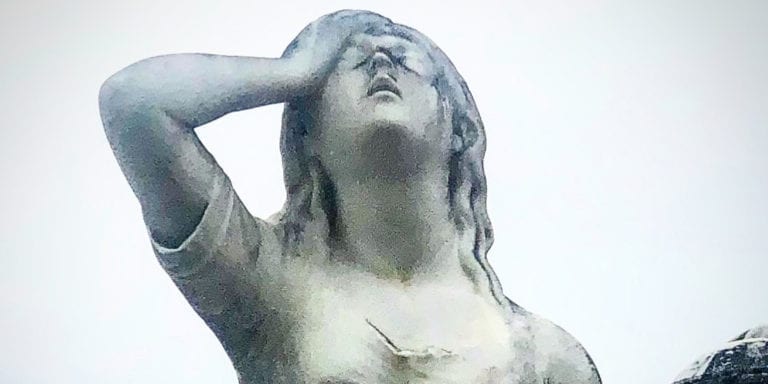
200!
My editor tells me this is Week 200 for these stories. 200 consecutive Fridays. There’s certainly some pathology involved. But I’m pretty sure I’ve shared a slice of life of what it is like selling books over the last 2 score years. A BIG slice. Counting my fingers and toes, in 8 weeks it will be 4 years. She also tells me this will be story #231. There have been an additional 4 guest stories. There are new chapters in the Round and Round series and Tree Song that are almost done. I just need to pull the trigger and send them off.
4 years of my life…
…and this bizarre past year…
Thank you for reading these.
Forgotten Ties—NOLA
New Orleans.
Why have I never visited?
I guess I thought it was all about parties, and I’m not a partier.
But I think I’ll find exotica. Southern, French, Cajun, Creole things.
I hope there will be bookish places. Libraries. Museums. Bookstores.
I know I’ll visit Crescent City Books. They moved to smaller quarters during the past year. COVID.
I left the warehouse late afternoon on Saturday, May 8, with plenty of time to get to Dulles.
I had worked all day.
I tried to kill off as many carts of mostly old books as I could. All have a blue slip of paper with my name on it emerging from a volume on the top shelf. Various sorters load those carts for me. They put books on them they feel I should make the final decision on.
I’ll be gone Sunday, Monday, Tuesday, Wednesday. I return at 5 a.m. Thursday.
5 a.m.?
Doesn’t matter.
Time and clocks have lost relevance to me during the Plague.
I used miles for the flight. Points for the hotel. Both accrued during the travel hiatus that was 2020 and the first third of 2021.
I’ll be in seat 1A. First class. It wasn’t very many more points than sitting further back. It is a smallish plane. 1 row of seats on port side. 2 on the starboard.
I had everything packed. I labeled the carts I worked on. I labeled the tubs and boxes.
I pulled the printout of the flight details I had taped to the door of the conference room several weeks ago. I climbed into the Explorer and looked.
7:30 p.m. takeoff.
Check!
Airport code DCA.
DCA? Dulles is IAD.
What?!
I needed to go to Reagan, not Dulles?
That meant I needed to go to the dreaded Beltway and cross the Potomac on the often-blocked American Legion Bridge. Then onto the often traffic jammed George Washington Parkway. This two lane—with no shoulder on either side—greenway winds along the Potomac River. Maryland then D.C. are on the left on the other shore.
I checked the navigation screen. I could still get there at 5:30. 2 hours before takeoff. Odd. It could only be because it was late Saturday afternoon.
I lucked out. I had never made the trip that quickly. That was the preferred route I take for downtown DC. Hockey, baseball, concerts, museums… It often takes a couple hours or more.
Of the three regional airports, Reagan is the last choice. I must not have noticed it when I booked the flight.
But traffic was light, and I fairly flew to the airport.
Maybe it was due to COVID.
I was two hours early!
There were three bars open in my gate area. I decided to have my traditional preflight martini.
“Gin martini. Up very dry.”
“Up. Very dry,” was the reply.
This is what arrived at my socially distanced table.
It was disappointing, to say the least.
I’ll call that a COVID Martini.
The flight was smooth.
Yep. And I went First Class. Seat 1A.
First Class meant a free G&T and bag of crackers.
The word “mask” was used 79 times by the flight attendants.
“Mask.” “Mask.” Mask.” …
A four-year-old child was told she must mask up as she entered the cabin.
I’m not sure if she was the one wailing at a certain point in the far back.
“Pressure in her ears…” an attendant bemoaned walking to the front.
As we descended toward the glowing city, it occurred to me I DID have connections here.
My dad, Joseph Thomas Roberts II, went to Tulane in the 20s and 30s. He got his MD and PhD there. Last week’s story that showed his old faded green cloth Anatomy 3 ring binders—he lectured in Anatomy at Tulane. I salvaged them over 40 years ago. I used them to keep my handwritten business logs in for almost 15 years.
He had told me stories of New Orleans in those rough days. He volunteered as a doctor at the orphanage where Louis Armstrong had grown up not many years earlier. He had his own rough experiences as well.
I had forgotten?
I certainly hadn’t thought about for a long time.
And my brother Tony who just passed away—his name was Alton Ochsner Roberts. One of the first things I saw on the big screen in the Louis Armstrong Airport was an ad for the huge Ochsner Clinic here. It came right after the ad for Antoine’s Restaurant—Since 1840.*
* The once extremely popular novel Dinner at Antoine’s by Frances Parkinson Keyes still appears quite often at Wonder Book. It doesn’t sell, however. Maybe I just haven’t tried. “Memo to self: Force a few copies online and see what happens.” It is a mystery novel of sorts. I still laugh about finding it misfiled in Cooking at the store long ago. Keyes (rhymes with “skies” not “keys”) has an interesting story.
Alton Ochsner was a mentor of my dad at Tulane. He also has an interesting story. It says the clinics he founded saw 650,000 patients in the past year.
He must have had a strong influence on Dad to name his second son after him. The eldest was J T Roberts III. I have a nephew JTR IV—but the line stops there. It jumps to my younger son, Joseph Thomas Richard Roberts.
Tony told me a few years ago he had visited the clinic and met with Alton Ochsner Jr. I wish I’d asked more about that. The Altons’ meeting was cordial and curious, I would imagine.
Taking the taxi downtown ($36 prix fixe), I had that feeling you get—not deja vu—but a connection. My dad traveled these streets a lot nearly a century ago. That added a new layer to this trip.
He was very precocious. He graduated from San Marcos Teacher’s College when he was very young. 18? LBJ attended the school, and they knew each other well.
Dad had taken the family Model T from San Marcos to attend Tulane Medical School. His father, JTR I, was a doctor. EENT. Eye, Ear, Nose and Throat specialist. He died when Dad was about 20 after a long bout with congestive heart failure. I was that same age when my dad died suddenly in my arms.
I know about the Model T because it was a bone of contention between dad and Uncle Tampy (George Talmadge Roberts) in 1975 when we traveled to San Marcos to participate in putting my grandmother, Georgia Talmadge Roberts, into a nursing home and oversaw the breakup and sale of the home her father built which is now a Landmark. My aunt Alice was dying of cancer a few blocks away. The two brothers bickered over various items each wanted, and the Model T usage some 45 years prior was still a bone of contention.
The deaths were to come in a flurry soon after. Dad died a month after we returned from Texas. Mom had an awful time until her death Christmas morning 1977.
New Orleans… Dad often told me tall tales. He was a shortish man. 5’5″. But he was a tall Texan at heart. He sometimes wore the same big western cowboy hat that LBJ wore.
One story was he had been kidnapped near the medical school at gunpoint by a gangster. Taken with a bag over his head to a warehouse near the Mississippi and led up external wooden stairs, he could hear the heavy wheezing of a man. Probably shot in the lungs—as they approached the door, he heard the man gasp, followed by the unmistakable gurgling of drowning on his own blood. He was led back down the stairs and released after another drive with a bag over his head. He told me he was sure he would have been killed, whether he saved the gangster or not. Gangsters don’t like witnesses.
Another tale was of a drive across Texas from San Marcos in the Model T. He picked up a hitchhiker. The man began acting suspicious to my dad. At one point, he started to reach into his valise at his feet. Dad said he in turn reached under his front seat for the pistol he kept there. This continued off and on until the hitchhiker got out somewhere. Dad said he recognized the guy later from pictures in the newspapers. Was it Clyde Barrow?
He also told me about finding a trove of Spanish silver in a cave out in the Texas hill country when he was a boy in the early 1900s. When he returned, an avalanche had covered it. (It was a much longer story and more detailed.)
Tall tales from a short (brilliant) Texan.
NOLA
I got to the hotel about 9:30 (10:30 Eastern time.)
Unlike the San Francisco Hilton, the Waldorf Astoria Roosevelt Hotel was alive and vibrant.
People were coming and going through the vast lobby. They would pull their mask on upon entering and tear it off exiting the front door.
Check in was easy, and I understood much of what I was told at reception. I was separated by a plastic shield and a mask and the bustle going on behind me.
I had chosen this hotel because it was a Waldorf Astoria. I’ve been in a few. For many, many decades, there was only one. I’m guessing they extended the brand to other properties in the early 2000s. Was the first in Orlando? I stayed there a few times, and it was wonderful—although completely modern. This place was vintage—classic. Old wood, stone, marble, tile, oils… There are now 20 Waldorfs according to the site. It includes the iconic Caledonian in Glasgow where I stayed many years ago (before it was a Waldorf) on a family trip through Scotland.
The original—in NYC—I visited many, many times until its sad demise in 2017. I was a guest in its last days in late February 2017. It closed “for renovations” March 1st. It will reopen in 2022 with 350 guest rooms (down from 1416) and 350 condos. It can never be the same. My son gave me a souvenir book-shaped table from there last Christmas. He had purchased it at an auction of the hotel’s contents.
Every trip there offered some current or vintage memory of the history that passed through that lobby. This just popped up in a Google search about the New York hotel:
On August 3, 1932, some 200 people representing the “cream of New York’s literary world” attended the Waldorf Astoria to honor Pearl S. Buck, the author of The Good Earth, which was the bestselling novel in the United States in 1931 and 1932.
Back to New Orleans…
I was assigned my room, and the route to find it was explained. “2-10-48. 2 means you are in the second tower. The elevators are that way. 10 means you are on the 10th floor. Your room is 48. I was able to upgrade you to Deluxe King Mini Suite.”
“Why, thank you!”
I made my way up to the room. I was pleased. It was spacious.
You know you’re in a great hotel when details like this are attended to.
But the reason I sprung for The Roosevelt—the tipping point—was the Sazerac Bar.*
* Named after what many consider to be the world’s first mixed drink, The Sazerac carries as much history as its potable namesake. Just gazing at the famous Paul Ninas murals flanking the African walnut bar takes you back to the grandeur of old New Orleans—a time when Huey P. Long would stroll in, order a Ramos Gin Fizz, and spend the next couple of hours talking to his constituents. Restored to reflect the spirit of the original establishment, elegant bar stools and plush banquettes invite locals and visitors alike to enjoy hand-crafted cocktails and free-flowing conversations. Make your night one to remember by starting it off in style at a New Orleans institution recently named the #1 Hotel Bar in the U.S. by thousands of voters in the 2018 USAToday 10Best poll.
Setting my bags in the room, I turned and returned to the lobby.
“Do you have a seat at the bar?”
“Help yourself.”
There were barstools! Not the Plague protocol 2-seater tables that most public bars seem to feel are necessary. There were two empties at the far end.
“Sazerac, please.”
Soon a couple approached, looking for 2 seats. I stretched and didn’t see a single along the long line of stools holding people sitting shoulder to shoulder. But I could be missing something.
I told the bartender, “I’ll be glad to move if there’s anything open.”
A beautiful woman laid her hand on my forearm. “Don’t you worry. We will be just fine.”
She climbed up onto the stool just inches from me. Her partner had to stand next to her on the other side.
I am shy—especially in public. But she wouldn’t have it. She was already pretty high. Her voice had a soft slur. But she had her wits about her. She engaged me in conversation.
She told me about her Hemingway collection. I don’t recall how we got there. Perhaps she asked what I did for a living?
Had I ever been to his place in Cuba?
I ordered a second sazerac. It appeared larger than the first.
The conversation went on. We often had to lean in to understand one another.
She ordered another champagne.
Her boyfriend—still standing and drinking a Diet Coke leaned over, spoke softly and affectionately kissed top of her head goodnight.
We (she) continued talking for an hour or so. I showed her pictures of the book warehouse on my phone.
She “oohed and aahhed.”
At some point, she showed me a picture of a strikingly beautiful young man.
“This was my husband, Giancarlo years ago. His family are wine merchants. We lived in Milan.”
He was so beautiful.
She talked about growing up in New Orleans. She lives in Colorado now.
“It is so dreary. There is no history there. No layers.”
I told her a bit about my life and the books.
I ordered a third sazerac. She asked for my phone number. A text popped up.
“Hey! This is Michele Fr…”
I replied with a photo of some vintage leather we were staging for a movie.
There was no question of it being a pickup or anything sordid. Just southern hospitality, albeit a little drunk.
She was leaving in the morning. It was my first day.
She rose to leave.
“Are you going to be ok?”
“I will be just fine. It has been a pleasure to make your acquaintance.”
I turned and watched her move through the room toward the exit. She didn’t walk…she “moved.”
“What was that all about?” I wondered.
I finished my 3rd drink—which I’m certain was twice as big as the first.
I found my way through the soaring lobby. Huge glittering crystal chandeliers lit my way.
One of the elevators was waiting with its door. A frosted glass globe above was lit. “This Car Up.”
On the tenth floor, I wended my way through the turns in the hallways and found room 48.
I fell into white linen clouds of opulent bed and floated away quickly.
Sunday
It was odd not being at work. I wondered what books I was missing back in Maryland.
I’d made no plans. Although I’d only had an airport salad on Saturday, I was not hungry. There were some cobwebs from the trip (and the martinis and sazeracs from the night before.) They weren’t painful. Just fuzzy.
I like to get the layout of a city I’m new to the first day. I trust my feet and eyes to find serendipitous experiences.
I stepped down the red-carpeted stone steps to Roosevelt Way. The masked doorman in livery—a black bowler hat, red silk vest, white shirt, black bow tie and black pants was very gregarious. Maybe it is a New Orleans thing. My mom, from Alabama, made friends instantly wherever she went.
“Do you need any help?”
“Which way is the French Quarter?”
“Two blocks that way. Bourbon Street is just beyond. You know Bourbon, don’t you?”
“Yes. I do.”
I’m writing this Tuesday morning. I had the longest deepest sleep I can recall. I floated unconscious in clouds for many hours. The fear and stress of COVID and the emotional draining of my brother’s death and the aftermath and the loss of friends seem to be behind me. At least this morning. Thunder is booming outside. My phone has had 5 Flash Flood Warning Alerts pop up since very early Monday. I full expected when I went downstairs Monday morning to find the streets flooded. The forecast was for rain every day I will be here.
“Enjoy Nawlans!”
Indeed a couple blocks on, I was in the maze of streets that is the French Quarter. It was about 10 A.M. Sunday when I turned a corner and came upon this scene.
City employees were hosing off the streets and sidewalks. A big street sweeper was rumbling toward me. The driver would climb down now and then and inspect the rubbish and pull something out and toss it on the sidewalk. I suppose they were things that the machine shouldn’t pick up?
There was a smell of stale beer pervasive everywhere. I had to watch my step to avoid vomit or other stuff I’d rather not step in.
“Is this the result of every night here? Or just Saturdays? Or are people overcompensating for the months of COVID closure?”
I wandered the old narrow streets.
Only Bourbon Street was so trashed.
I wandered into the Basilica of St Louis.
Sunday Mass was in about 40 minutes. I lit a candle to my original family—all gone now. Then I sat in a pew off to the side and in the back. Breathing in the peace and contemplativeness of the soaring space around and above me, I gave thanks for what I have been given. I asked to be given the chance to do more—better and good things.
“…forgive my trespasses…”
I left before Mass started and walked past the juggler and magician, the artists and scammers just inside the entrance.
A man sidled up to me and said, “I like your shoes.”
I’ve heard that line a couple times in Europe.
I was to hear it here another half dozen times here.
To avoid engagement with whatever scam he wanted to perpetrate, I mumbled, “Thanks,” and peeled away from him.
There’s a beautiful park across from the church. In its center is a massive equestrian statue of Andrew Jackson.
I wonder if his days are numbered.
I passed through the gardens and walked up the steps to a high raised wall separating the city from the river. Is it called a levee there—in downtown? From there, I looked down at the Mississippi. Big, brown, ponderous—I couldn’t tell in which direction it was flowing. I wasn’t really oriented yet as to which side I was on.
It took my breath away.
I sat on a step and, in a daze, dashed down some lines.
The Big Muddy rolls and flows
Heavy waters seep to sea
So ponderous, I wonder
“Which way does it go?”
I spot a leaf
Watch its progress
And I know where I am going
This city tells me time
I am old. They are young
I do not wish I was young like them
I wish I was young like me
Lacking only their fewer years
I feel the same
Only older and stabler
The body unchanged
The body unchanged
The river’s time’s eternal
A moving living thing
It passes slowly by
Measuring my presence here
as less than seconds
My presence in this world
A drop of water in the Big Muddy
What would I do today? I had no plans. I hadn’t studied the DK Travel Guide I brought with me.
Sometimes I’ll take one of those hop-on hop-off bus tours on my first day in a new city… Most cities have hawkers in bright corporate colored shirts on almost every corner trying to get you signed up. The HQ for a Red one was tucked under the “levee” below me on the city side. There was a woman in a red polo standing out front, but I chose not to go back down that far. I’d sign up somewhere in town. But I never saw a bus.
COVID, I suppose.
I walked along the levee toward some paddlewheel steamboats. There were lines waiting to board all three of them. “The City of New Orleans.” It might be nice to be riding on the City of New Orleans. But it looked like too much effort. I was only in the mood to do easy things my first day in the Big Easy.
There were only two people in line at the Audubon Aquarium. That’s easy. I love seeing all of nature’s amazing variety. I was a zoology major in college, and creatures appeal to me. (As do plants and rocks and books…)
It was fine.
I continued down the Riverwalk until its end at a chain-link fence with rusty commercial dockyards beyond.
Beyond and above them, a long bridge crosses the river. Hundreds of tiny cars and trucks were moving across it. An Interstate, I presume. I would walk across that—just to say I crossed the Mississippi, but I could tell there was no provision for pedestrians. Good thing. I would have to walk back.
I walked and walked, trying to get the layout of the city. It was pretty busy. It seems about 2/3s of the restaurants were open and about 50% of the shops.
There was not the feeling of dystopia I felt in downtown San Francisco.
I stumbled upon a used bookshop. I stepped inside. The workers were elderly—much older than even I. My entry and presence was not acknowledged as I walked along the book-lined three-wall perimeter. Crusty and old school. There were a lot of “book” books—general stock—like my shops. I knew there would be nothing in open stock for me. I chose not to interrupt the old fellow seated with his face down in a book at the glass case and collectible bookcase behind it near the front.
Sigh…book people…
I cut back and crossed the length of the French Quarter. I then headed north. I wanted to see the famed St Louis Cemetery #1. All the old graves are housed aboveground. Underground it is too wet. I loved the European “Cities of the Dead.” Paris has the best ones. It was a pretty long walk up to the northernmost limit of the Quarter. When I got to the gate in the old wall, I saw it had a big chain locking it. A sign said visiting was only permitted with licensed tour guides. Another sign stated there were no tours currently.
“COVID.”
Maybe there was concern the graveyard’s residents might catch the Plague.
Death, food, booze, partying, music…in the commercial areas.
Gentility and a slow life seems the mood in the residential areas.
I stopped in one of several voodoo shops. I chose not to get a reading in the back.
I’d prefer not knowing my future.
I passed a young woman lying on the sidewalk. Her long hair was golden and naturally gently curled. Her hair could have adorned a Pre-Raphaelite beauty in a Burne-Jones painting. I couldn’t see her face. She was facedown on the pavement. From behind, her body appeared to be pretty young. She wore sky blue jeans. Her crotch was stained with old dry brown, black and dark red splotches. A woman knelt by her and asked if she was ok. There must have been a positive response, for she rose and left.
I moved on, wishing I had the years she was wasting away.
I headed back for the hotel to take a break and another shower—my exertions had gotten me very sticky. Also, I hadn’t entirely shaken off the cobwebs of the travel and sazeracs of the night before.
I fell into the cloud of while linen and pillows and floated into a nap.
The plane just took off from Louis Armstrong. It rose swiftly over the Gulf of Mexico. Soon it was in a layer of clouds. In a moment it pierced through them, and we were above a vast cotton ball blanket of clouds. Falling into the plush bed was a lot like that. And I recalled the trip we took six years ago and that plane dodging through thunderheads before descending on the city where I was born and grew.
The bed.
It was luxury.
I didn’t have anything I had to do. I couldn’t feel guilty about not doing work that I “could” be doing. The air-conditioning chilled the room.
I woke. Wrote some of this. Then dozed. Woke. Transposed and dozed.
I rose in the late afternoon. I decided to head for my friend Joe Phillip’s Crescent City Books.
It was only a few blocks away from the hotel. It used to be directly across from the fancy rear entrance to the Roosevelt. He had to move a few months ago. COVID.
We used to send him common NOLA related titles by the hundreds before the Plague.
He bemoaned losing his larger location earlier in the year.
Joe is an amazing bookseller. He owns four high-class bookshops on the eastern half of the continent. Boston. Newport. Sarasota (with a partner.) And NOLA. I’ve been to the Boston shop. Commonwealth. It is wonderful. Go. How he can run those diverse places, I dunno. But then people wonder what Wonder Book does. Easy. Inertia.
I crossed Canal St into the French Quarter. Then a couple more streets before turning right on Bienville. The shop was bright and inviting. From the large plate-glass windows, visions of beautiful books poured out. It was busy too. The sidewalks were bustling, and occasionally a couple would turn and pull the door open to enter.
I introduced myself at the counter, and they recognized me as the guy who sent them boxes of Anne Rice, Paul Prudhomme, Frances Parkinson Keyes, Creole this or that…
The counter was made of two glass cases, and just beyond two tall glass front cases lined the wall. Beyond were open cases of old cloth and leather.
The good stuff. Kept near the front.
The glass must have been magnetized, for I was immediately drawn to it.
I’m not exactly jaded about almost all of the books I see by thousands every day, but it does take a certain kind of book to get my juices flowing. There were a lot of those in the cases.
The two tall cases were unlocked, and the doors slid open so I could get at them.
As always happens around purely wondrous tomes, I was transported—to somewhere not on this plane.
I looked and read spines. I gently slid one out and lifted it slightly so as not to rub its base when I set it back in. I repeated this with one book after another. One more after the other.
I made a little stack on the glass counter.
Well, not so little. The six volume Faerie Queene loaded with Walter Crane woodcuts is about 16 inches across.
The Swinburne William Blake was stunning.
“I’ll be back tomorrow. I’m sure I’ll find more.”
Joe had emailed about 3 pages of advice he sends to people visiting NOLA for the first time. One recommendation was Mr. Ed’s Oyster House just a couple blocks further on Bienville. There was a little line out front, but I spotted a seat at the bar through the window.
“Go ahead on in. It’s yours.”
I sat shoulder to shoulder. Across the bar to my left, a shucker was creating trays of oysters on the half shell. I figured each tray held about thirty.
Oysters by the gross!
Joe had written: “Be sure to get the charbroiled oysters. Chuck, I live on these when I’m in town.”
I started with half dozen raw. They were nearly half as big as my fist. They came on ice with lemon, horseradish and cocktail sauce. I reached for the little bottle of Krsytal Hot Sauce and dashed some on each mollusk. They were big and sweet and a little salty.
Then the charbroiled came out bubbling and sizzling.
With all the topping, they WERE as big as my fist. A ten-inch loaf of toasted French bread was also on the platter. It was topped with shaved garlic and chunky salt and butter. It rested in a pool of butter.
My fingertips also tasted delicious.
“Chuck, an Abita beer goes along with oysters perfectly.”
Exactly!
I finished with turtle soup. (I presume farmed snapping turtles.) It was very much like the Bookbinders version I’ve had at the Drake in Chicago, only instead of a little vial of sherry accompanying it, the sherry was already added.
It was the most unique meal I’ve had in a long time.
I wandered around the Quarter some more, taking in the sights and sounds and smell. The beautiful and the ugly. The classiness of restaurants like Antoine’s. The sad depravity of the strip clubs and pot shops and plastic cup boozers.
Back to the Waldorf. Its lobby is just stunningly beautiful. Old school high class.
I climbed up on a stool in the Sazerac Bar and ordered one of them. I checked the website on my iPhone:
Fame comes in many forms. And The Roosevelt has seen virtually every kind during its century-long history. The Roosevelt has attracted names that fill volumes of “Who’s Who in American History” or “Lifestyles of the Rich and Famous.”
Sonny and Cher, Frank Sinatra, Judy Garland, Marilyn Monroe—they’ve all dined or hosted here. Marlene Dietrich was among the famous performers appearing at the Blue Room. In her case, it was near the end of a lengthy career in 1975, and she was requesting oxygen between songs. Douglas Fairbanks, Jr., Audrey Hepburn, Ginger Rogers and Bob Hope were here. And style and beauty, because what other words better describe Grace Kelly?
From politics to royalty, we have greeted many U.S. Presidents, including Calvin Coolidge, Dwight Eisenhower, Gerald Ford and Bill Clinton.
And, of course, Huey Long, who was so enamored with the hotel that he reportedly built Airline Highway from Baton Rouge to shorten his drive. The recreated “deduct box” located in the lobby pays tribute to the original, into which it was said government workers deposited “donations” to fund Long’s political aspirations. General Manager Seymour Weiss continued to serve as Long’s financial adviser until Long’s death by an assassin in 1935.
Dignitaries, too, have created their own kind of sparkle at The Roosevelt, including M.J. Rathbone, president of Standard Oil of New Jersey; Upton Close, the fabled war correspondent; even Douglas “Wrong Way” Corrigan, pilot of the sensational wrong-way flight to Ireland.
Throughout history, The Roosevelt has seen it all.
I ordered a second—not thinking—they are so good.
“Can I take it to my room?”
“Certainly.”
Even the elevators evoke grand history. I would discover there was always one waiting open for me. The words illuminated above: “This Car Up.”
I set the drink on the nightstand and fell into bed.
I awoke about midnight. The drink was still there. I sipped it while I wrote, transposed and made reservations for the next day.
I couldn’t face venturing out into the city so late and alone.
Plus, the room was heaven. Why leave heaven for Bourbon Street after midnight?
Tuesday I walked all the way across the French Quarter for my scheduled tour of the Beauregard-Keyes house.
Long, long ago a collection of about 20 books signed by P. G. T. Beauregard came into the shop. I still have a few somewhere. The Civil War is certainly out of favor these days. Especially the southern side. My DK guide was a used copy. I got it from Wonder Book. It is about 10 years old. A lot of the landmarks listed in it have been removed.
The house was a beautiful Greek Revival building. Its living level was raised about 8 feet off the street—flooding, you know. The docent did a great job explaining the history of the building and function of the floor plan.
She went through the list of previous owners and what they did with the building. One antebellum owner was a Sicilian wine merchant. He kept his goods stored in the stone space under the house. One night four men visited. He shot them all. Three died in the house. The fourth died some blocks away. It was asserted they were representatives of the Black Hand (Mafia) come to extort the man and his family. He was acquitted.
I’ve gained more respect for Frances Parkinson Keyes (Keyes rhymes with pies.) She was the last owner and left the house as a memorial. There are a lot of her books there. I think I might pick up Dinner at Antoine’s to read. I always kind of thought her work was aimed at women, but perhaps that is prejudiced on my part.
Also, since I couldn’t have dinner at Antoine’s because it is closed Monday-Wednesday (COVID?), perhaps I can experience it vicariously. Peering in its windows, it appears quite grand in a Belle Époque kind of way.
She also left a beautiful garden adjacent to the home.
My second stop was the World War 2 Museum. It is rated the #8 in the world by TripAdvisor. It is all the way on the other side of the French Quarter, and I had had enough walking from Sunday and this morning. I summoned an Uber. Just in time. The skies opened just as it pulled up.
The museum was quite comprehensive and evocative. I teared up more than a few times at the privation, suffering, death and horror that people endured for those years. Our little Plague this year, as tragic as it’s been, looks like (and I fervently hope) it will just be a blip in most of our lives.
It is a vast multimedia experience although all the touch screens and interactive exhibits were turned off.
(COVID.)
I walked around some more before wandering back across town into Crescent City Books. I added to my pile before venturing down to Mr. Ed’s for more oysters and Abita. They serve oysters 8 ways, but they are so big and a rich I could only sample 2 different half dozen a night.
Here are the choices.
I wandered around the maze of streets taking in the architecture and humanity and crass commercialism and artistry and weirdness.
I didn’t have it in me to stay up for music and barhopping alone, so I headed back to the Waldorf for a sazerac.
I stayed up a little looking at what I could do Tuesday.
For $3, I could get a day pass for the trolley. The St Charles line makes a long run to the west through the Garden District and into the large Audubon Park.
I had the longest, unbroken sleep I can recall. I awoke feeling renewed.
I wanted to visit the Tulane Medical School where Dad spent so many years getting his doctorates and teaching and doing charity work at the clinics. I looked online and saw only sleek modern soaring buildings. But the “campus” was only a few blocks away. I’d explore before I hopped on the trolley.
I wandered the streets that comprised the campus. I finally came upon an old building. Could this be it?
For some reason, I went around the corner into a side street and saw what looked like a secondary entrance but above the door.
My father walked up these steps thousands of times as a young man nearly a century ago. I felt his spirit or ghost, as though coming here had brought him back to see me after all these years. I walked up and touched the door.
As with most children, I thought my dad didn’t know much and so didn’t listen as much as I should have. He didn’t survive long enough to learn how wise he actually was.
When I was a boy of 14, my father was so ignorant I could hardly stand to have the old man around. But when I got to be 21, I was astonished at how much the old man had learned in seven years.
Mark Twain
But when he was gone, I soon knew what I had missed. I ached for him for many years.
I was reminded that he was a classmate of Michael DeBakey who remained an active surgeon until he was 100. When I was 6 or so, my mom and dad went to Houston—I think—where DeBakey performed a dangerous surgery to remove a kidney. They were gone for weeks. Mr. and Mrs. Ike moved in to take care of me because Jimmie was too wild and Tony and Joe were away at school. Mrs. Ike would usually come a couple times a week to help my mom take care of the house. I addressed her as “Miss” Hattie. I loved her like a mother. Her husband, Mr. Ike would bring me windup tin toys from time to time.
Another classmate and friend of my father was Luther Terry. As US Surgeon General in the early 1980s, he was an early proponent of the dangers of smoking. He would leave copies of this book around the house for my mom.
Dr. Terry was largely responsible for it.
It didn’t help. Mom smoked constantly until her death at age 63. This was after many years of physical and debilitation—likely caused by cigarettes.
Her addiction influenced me NOT to smoke—unlike my 3 older brothers, who were heavy smokers most of their lives.
I had dinner with Dr. & Mrs. Terry several times with Mom and Dad. Mrs. Terry was strikingly beautiful.
At Tulane, I stood looking at the ancient threshold to what had been cutting-edge medicine a century ago.
I thought of my father. Pictures of him. Trim, muscular. Dapper. A thin mustache. His curly hair combed back.
When he died, I was tasked with going through his papers and books since I was to stay in the house and take care of mom.
He had about a dozen old wooden and metal filing cabinets. I had just turned 21 and had to figure out what to do with all the stuff. He had hundreds of copies of offprints of articles he had written for journals. In the bottom of one drawer of an olive drab painted wooden filing cabinet, I found a locked brown metal box. I had to pry it open. Love letters and sepia photos of a New Orleans girl with blond bangs and wide soulful eyes.
Thursday morning
The new New Orleans airport is nearly empty. Everything is closed.
No.
Not COVID.
It is 4 a.m! I booked a 5:51 flight. Made sense at the time.
I enjoyed the trip.
Tuesday the antique trolley took me out to Audubon Park. It rumbled slowly through the Garden District with one stately home after another. There are so many beautiful homes in the city. So many meticulously kept up. It must be a challenge in the damp warm climate to keep the paint and woodwork pristine.
I walked around the massive park—down to the river and back. I was going to go to the zoo.
Closed.
COVID?
I got back on the trolley and hopped off back in the heat of the Garden District. I wandered the neighborhoods of one stunning home after another.
The guidebook said Lafayette Cemetery was a highlight. I found it using the map. When I turned the corner, about a half-dozen people were standing by the entrance.
Locked.
The sign said “For Repairs”, but peering through the metal bars I saw no sign of work. I suspect—COVID.
Back in the city, I went to the boutique bookshop in the little building where Faulkner wrote his first book. I wasn’t greeted but instructed to sign in the logbook. Name and phone number for “contact tracing.”
Right.
Not much to see anyway.
Then I went to the Monteleone Hotel where there are so many literary connections.
There was a long line in the lobby. The bar doesn’t open til 4? Why? If there are people lining up at 4, why not open at 2? Or noon? Merchants…go figure.
The people were waiting to get a seat on the iconic Merry Go Round Bar. It actually makes a complete circle every 15 minutes. I’ve been in bars where the room SEEMS to spin but this…
Back to Mr. Ed’s for oysters and red beans and rice and shrimp etouffee and Abita.
Sazerac.
Wednesday I took a different trolley line north to the City Park. The art museum was classic.
I needed a dose of that.
I wandered a bit along the park.
There was a Cafe du Monde in an old arcade building. I had beignets. The powdered sugar piled atop them fell through the grate in the metal table. My black jeans and shoes were spotted white.
The spots wouldn’t be dusted out due to the dampness.
I walked across to the bayou. Saw some very old architecture.
The guidebook said St Louis Cemetery #3 was near, and I made my way to it.
Open!
A City of the Dead.
I imagined this woman was trying to chip her way out of the tomb.
I decided to walk down the Esplanade rather than return to the trolley.
I wanted to see the Degas House—to which Edgar made a pilgrimage for some months. His mother and grandmother were from New Orleans. I decided I didn’t need a tour.
It was a long walk, but eventually I was back in the now familiar streets of the French Quarter.
I came across a little Jazz club that actually looked inviting. Fritzels. Inside a time capsule, a 1960s jazz club was evoked in every corner and wall thingy. I fantasized it was opened by a World War 2 vet and his wife, and whoever owned it now had left everything intact.
I sat at the bar and sipped an Abita. I thought about coming back for music that night.
Oysters at Ed’s.
Sazerac.
To bed early with a 3 a.m. wake up call requested.
I got back to the warehouse about 10 and did a dazed day’s work.
Home.
The gardens were gratifying. There are still some daffodils blooming. Some of the hostas have gotten huge. The vast fern brakes are greening.
I went and picked up Merry and Pippin.
Then I fell into my own bed with its purple cloud of crisp sheets.
It is good to be home.
I wonder what books I will discover this weekend?

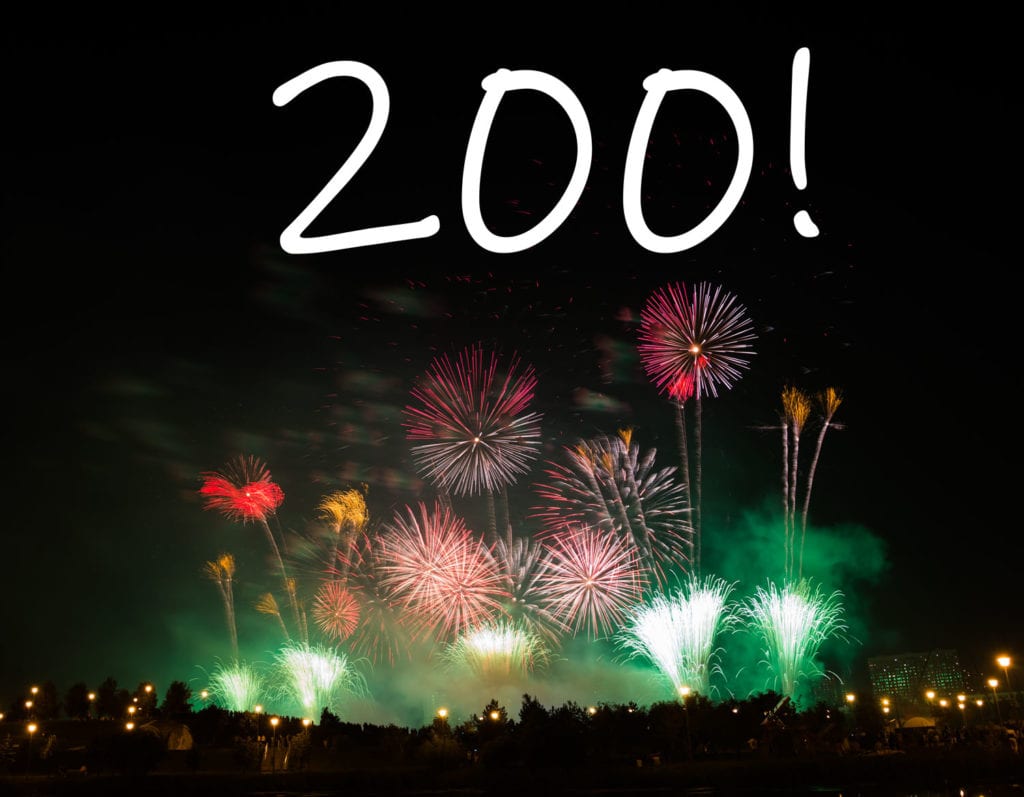
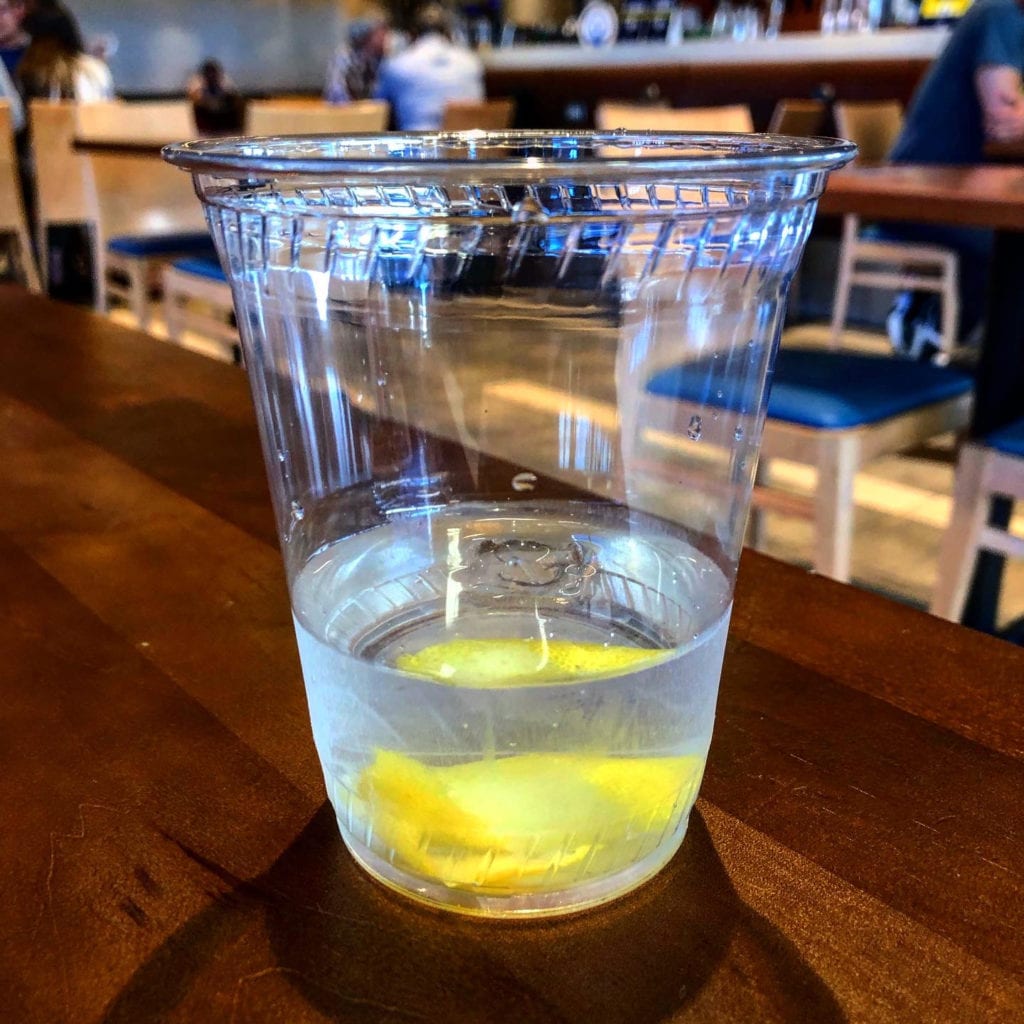
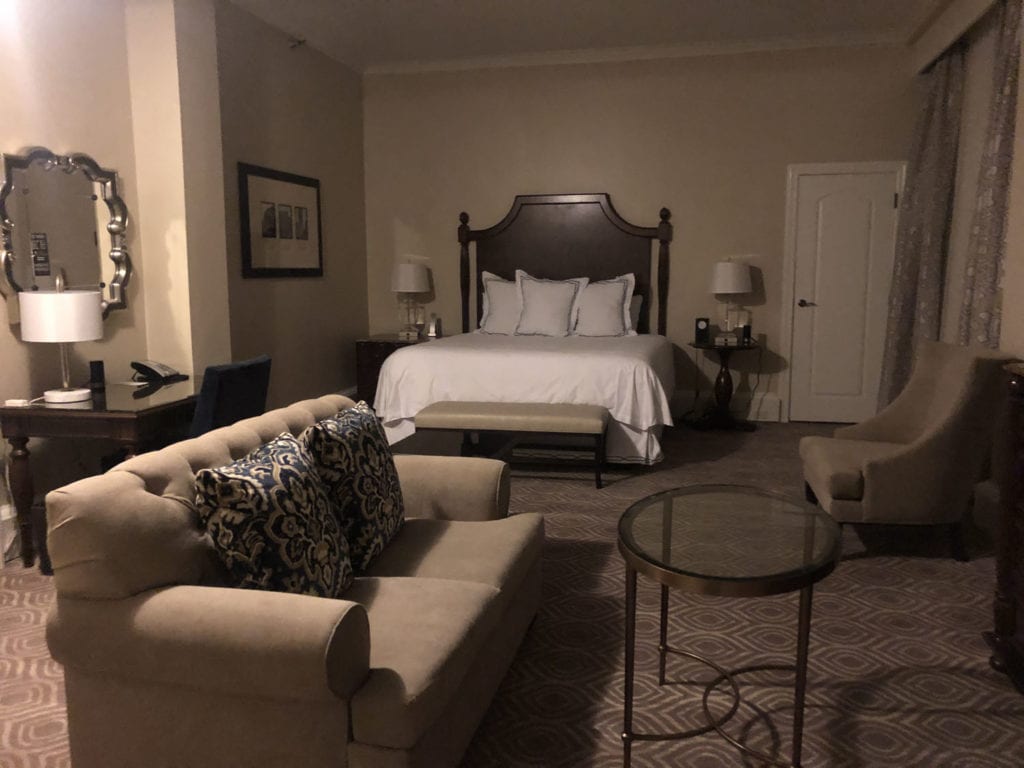
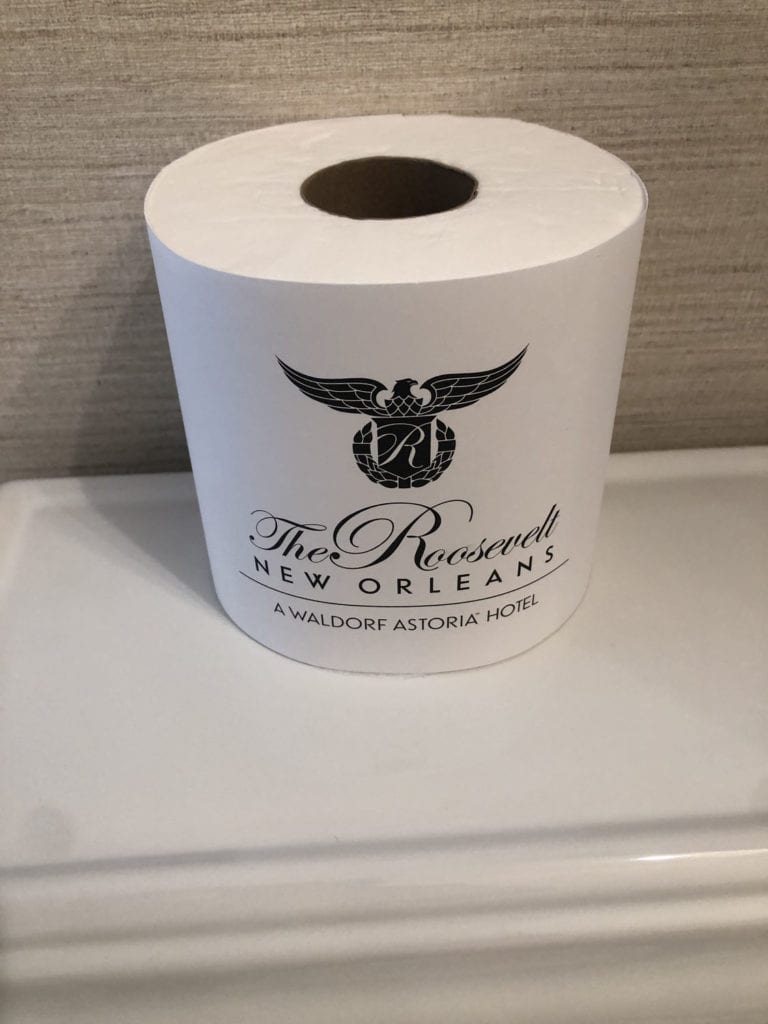
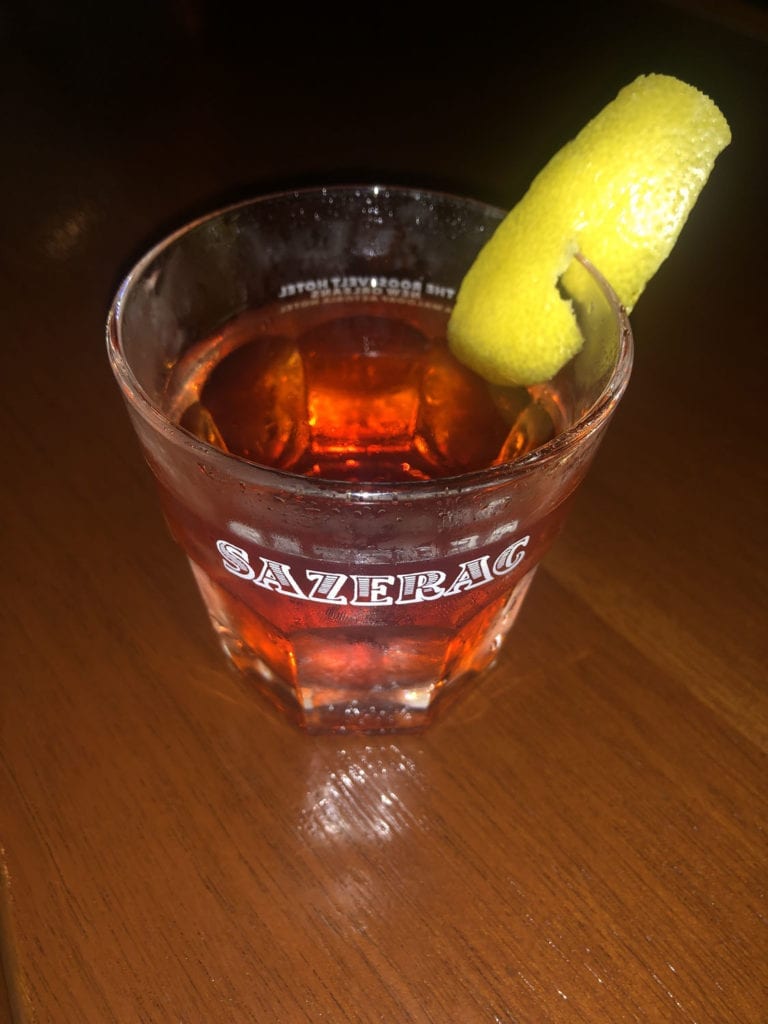
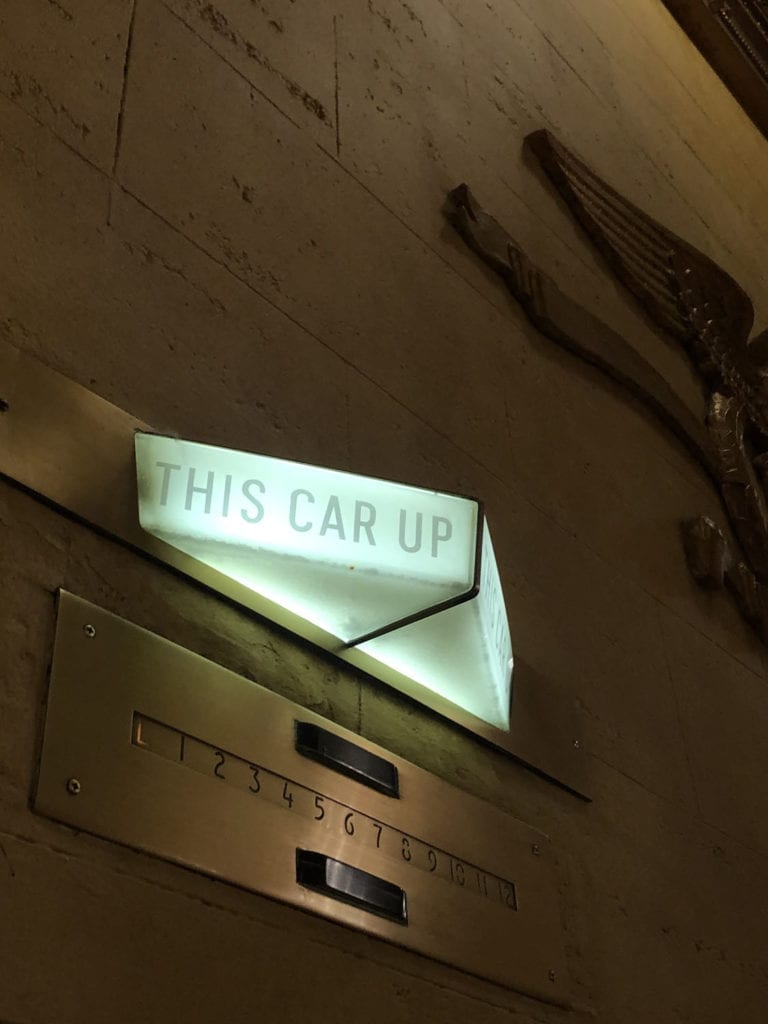
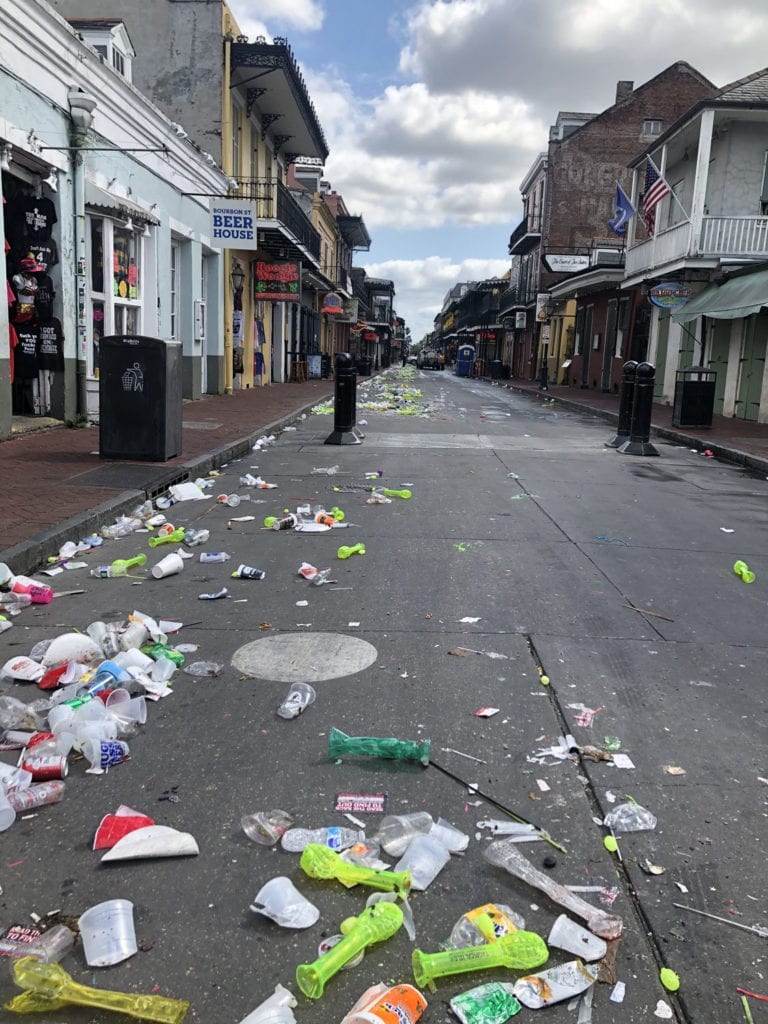
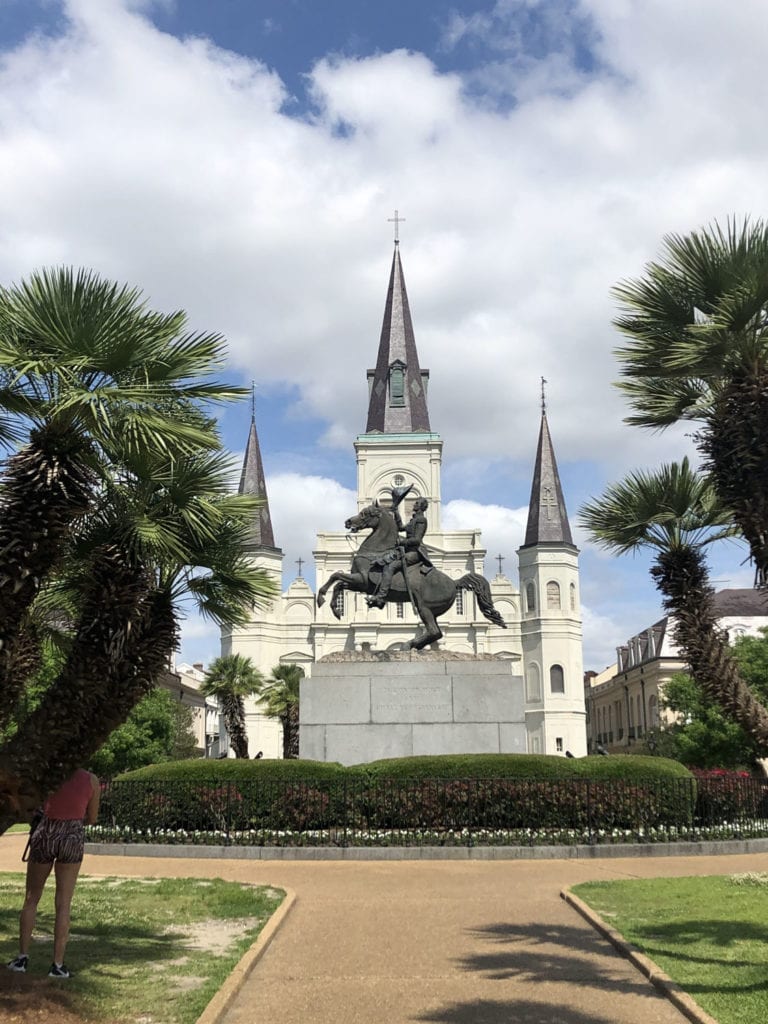
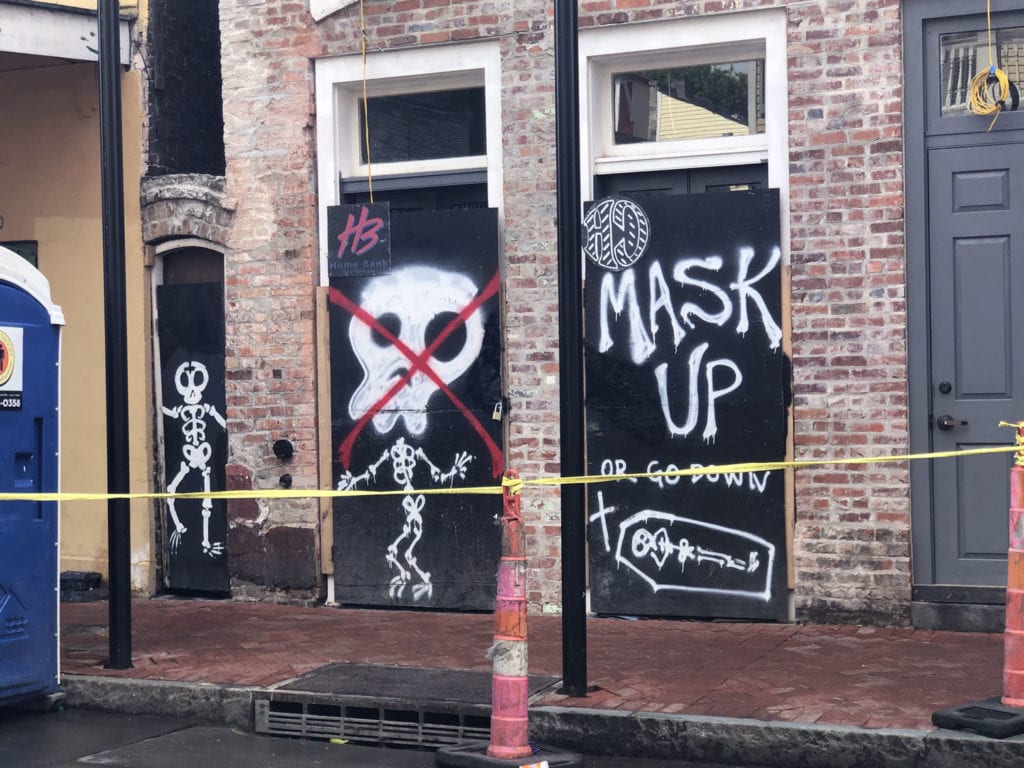
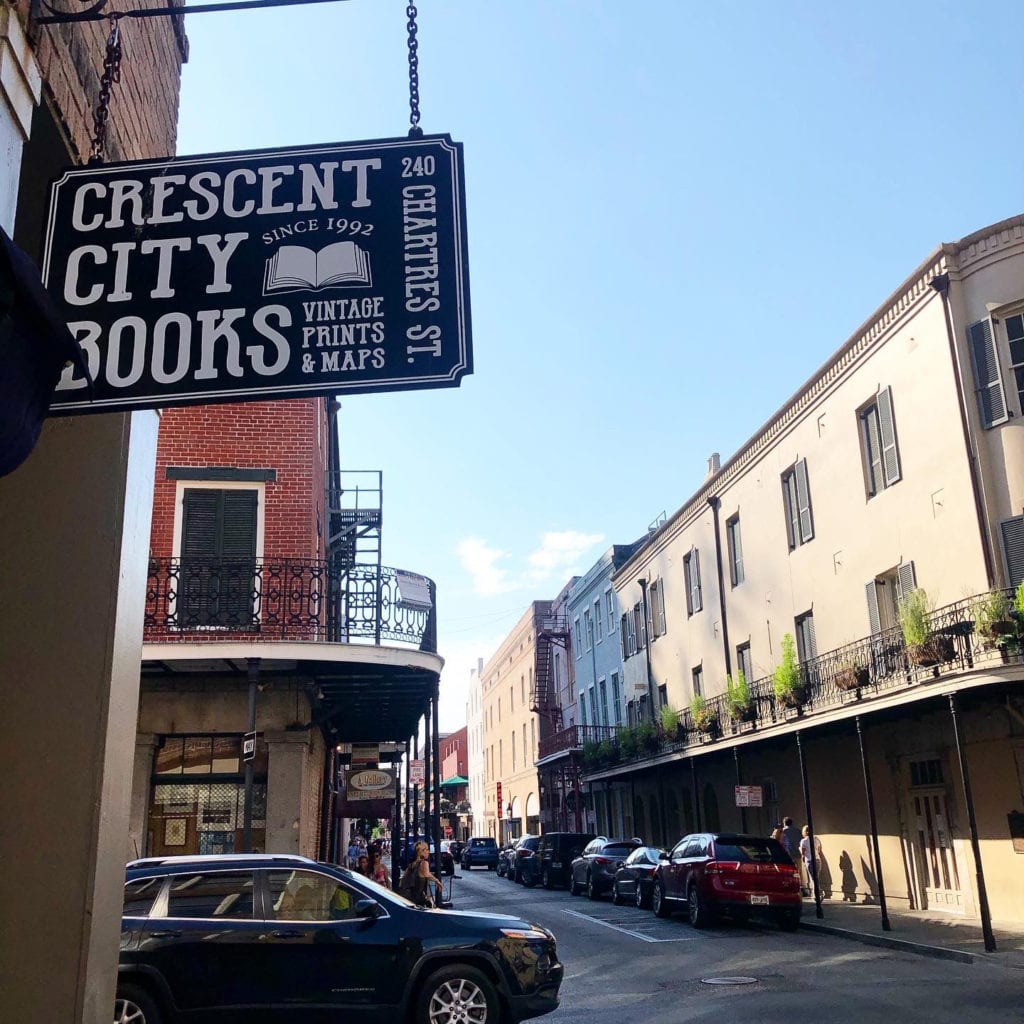
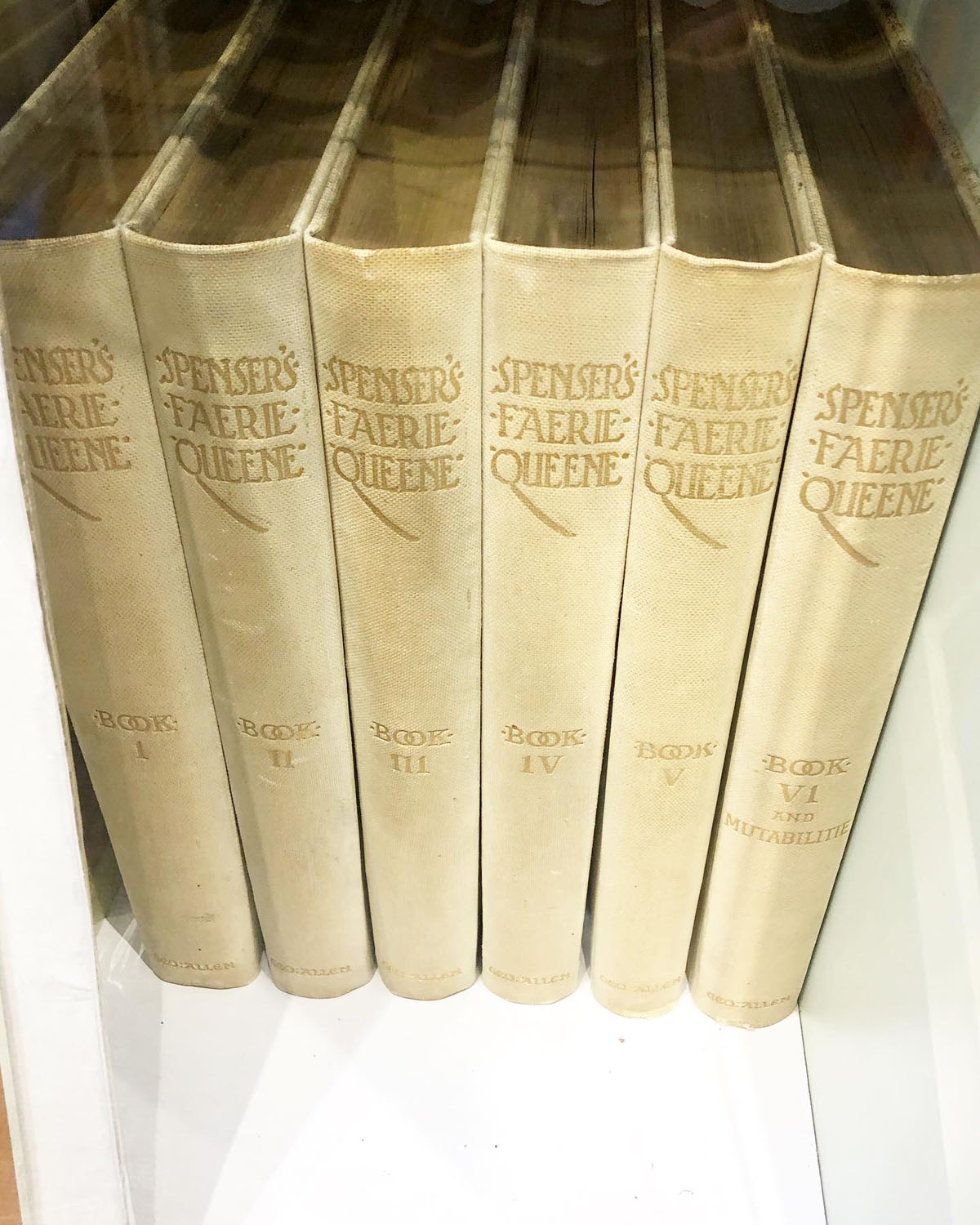
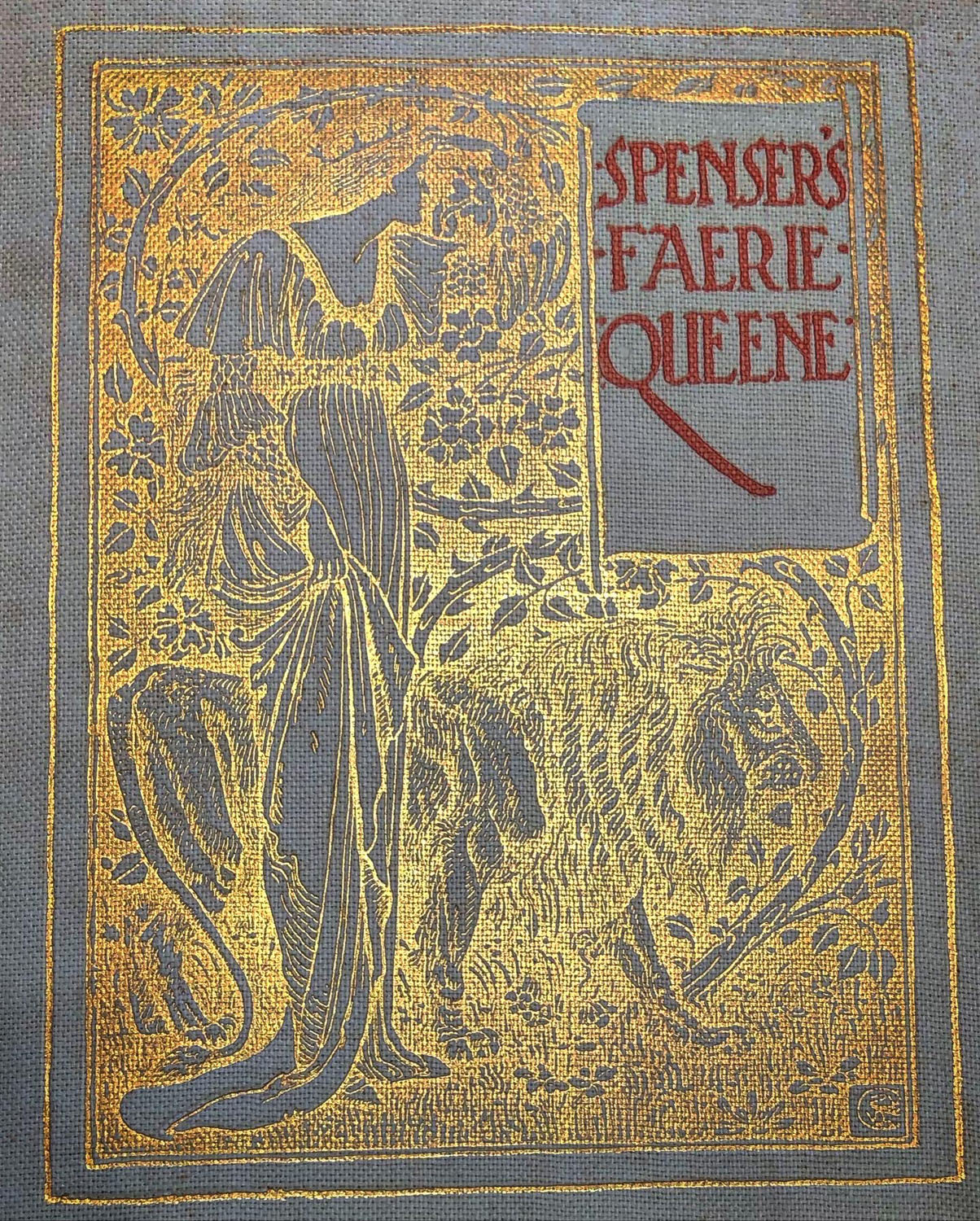
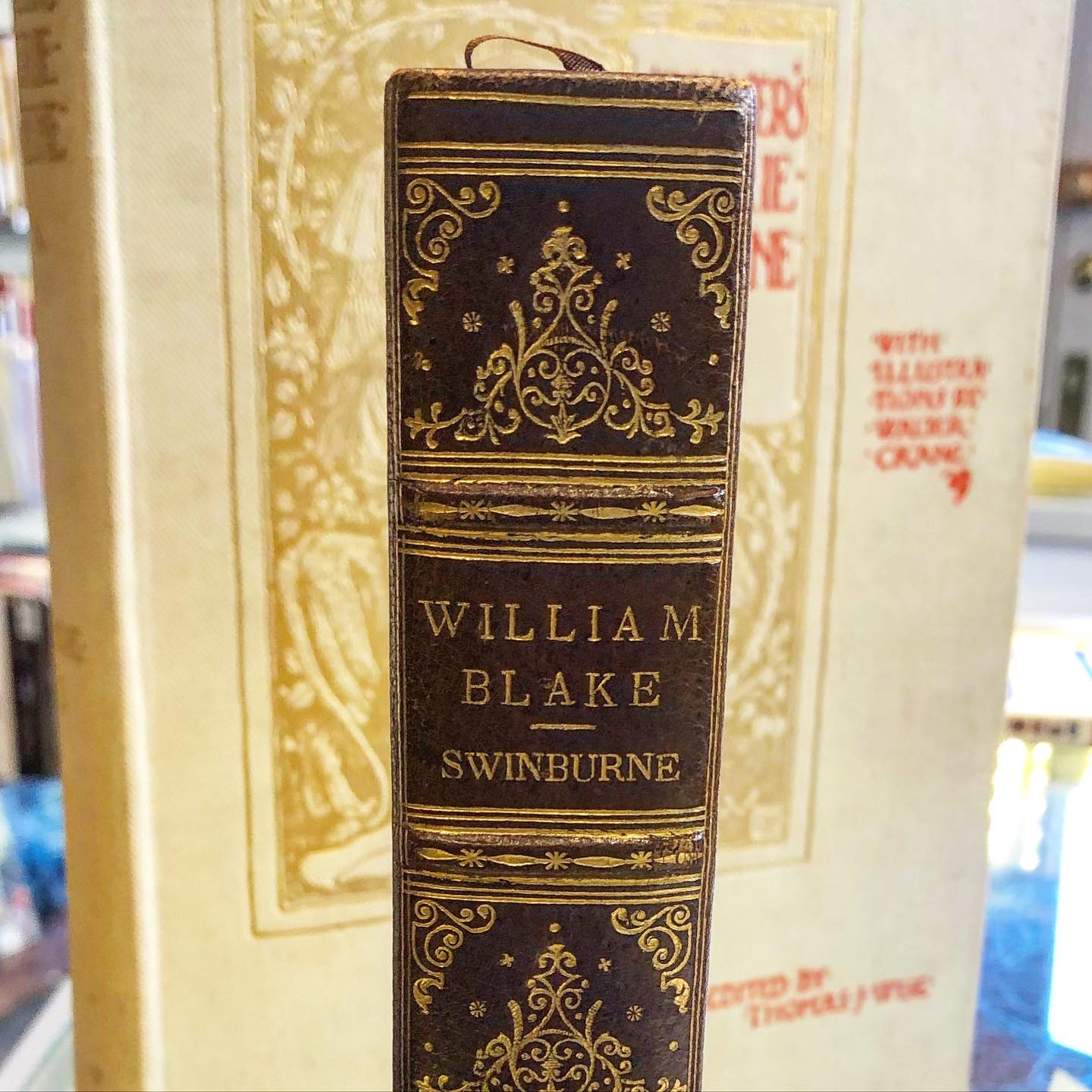
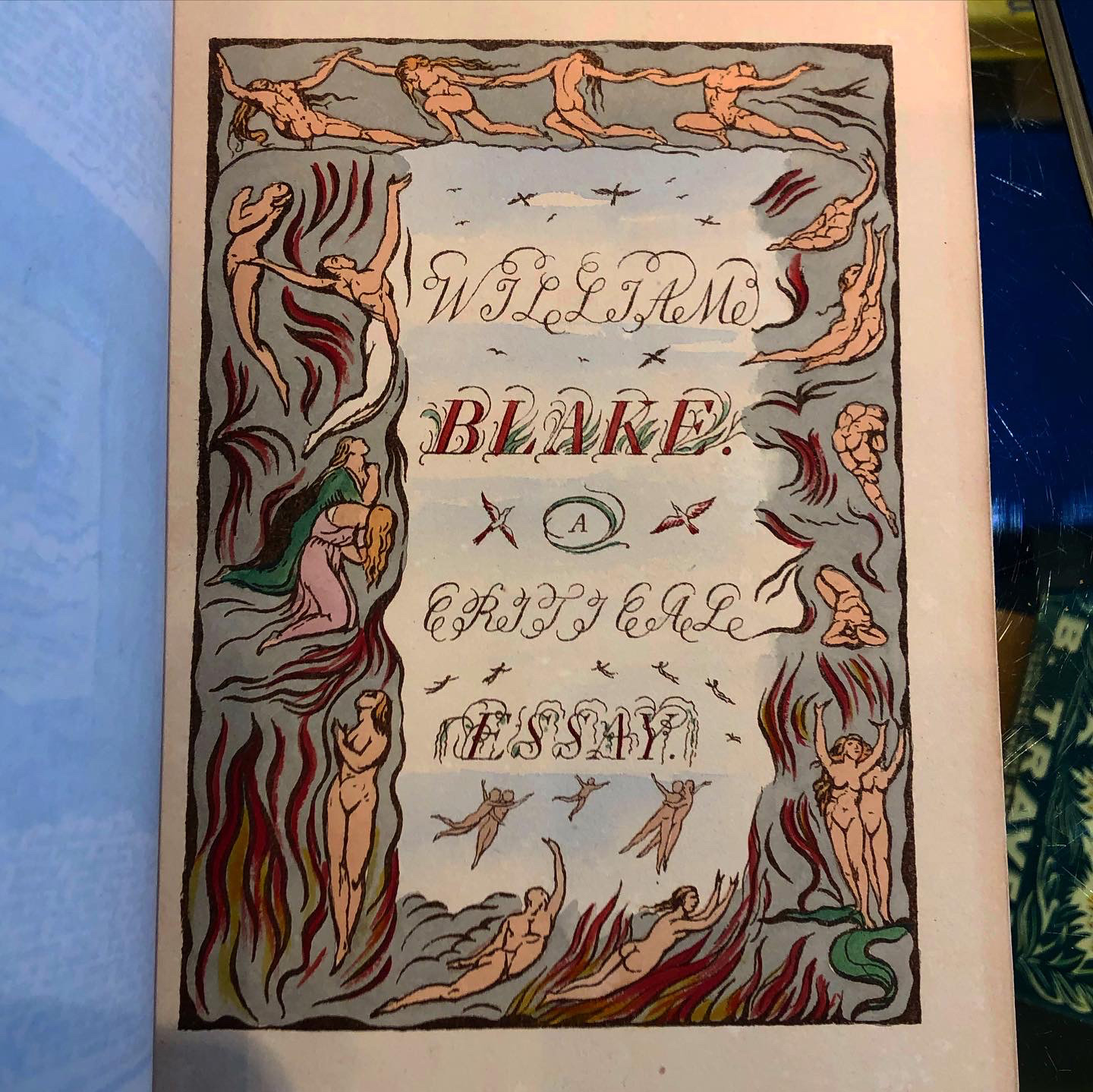
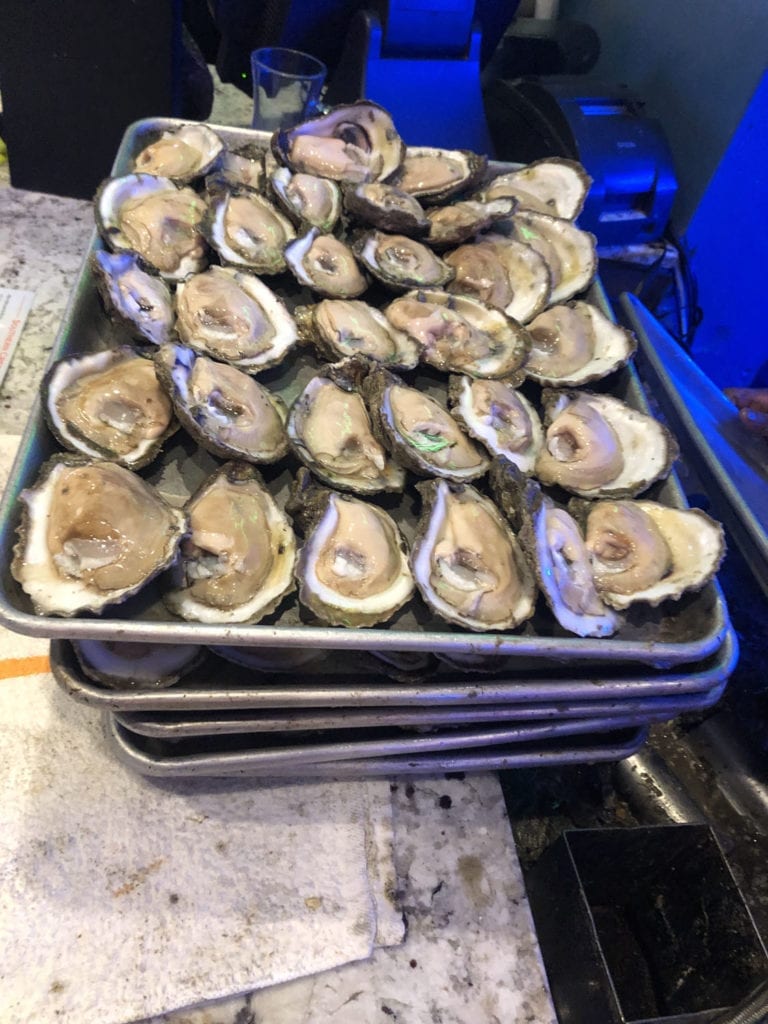
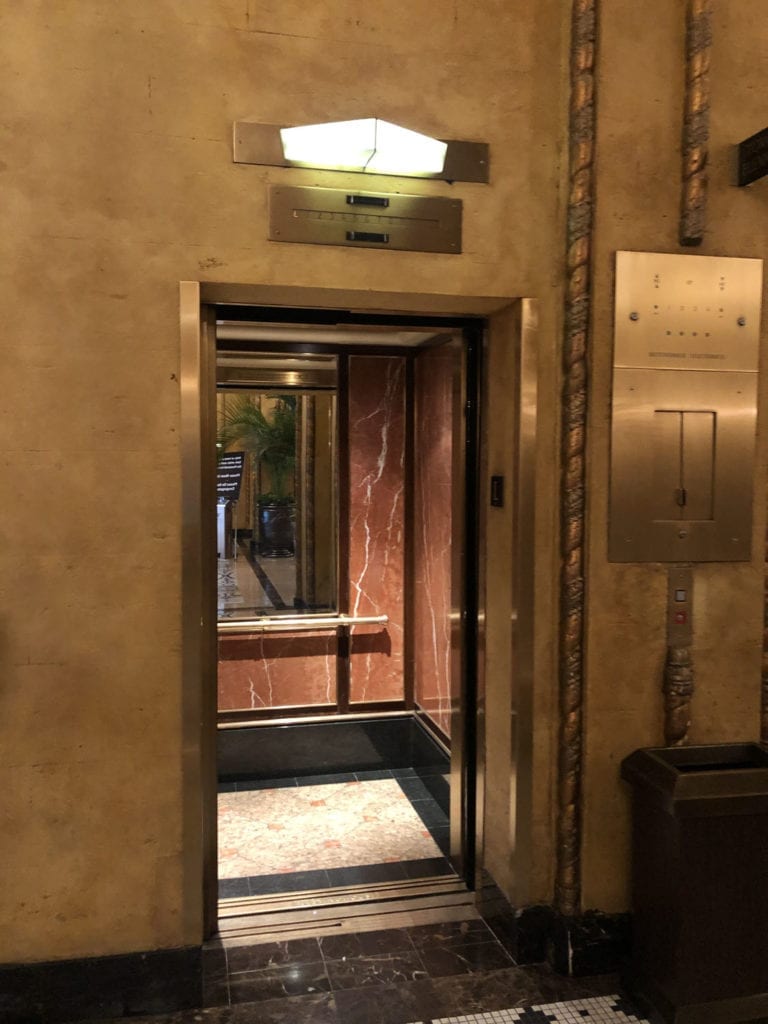
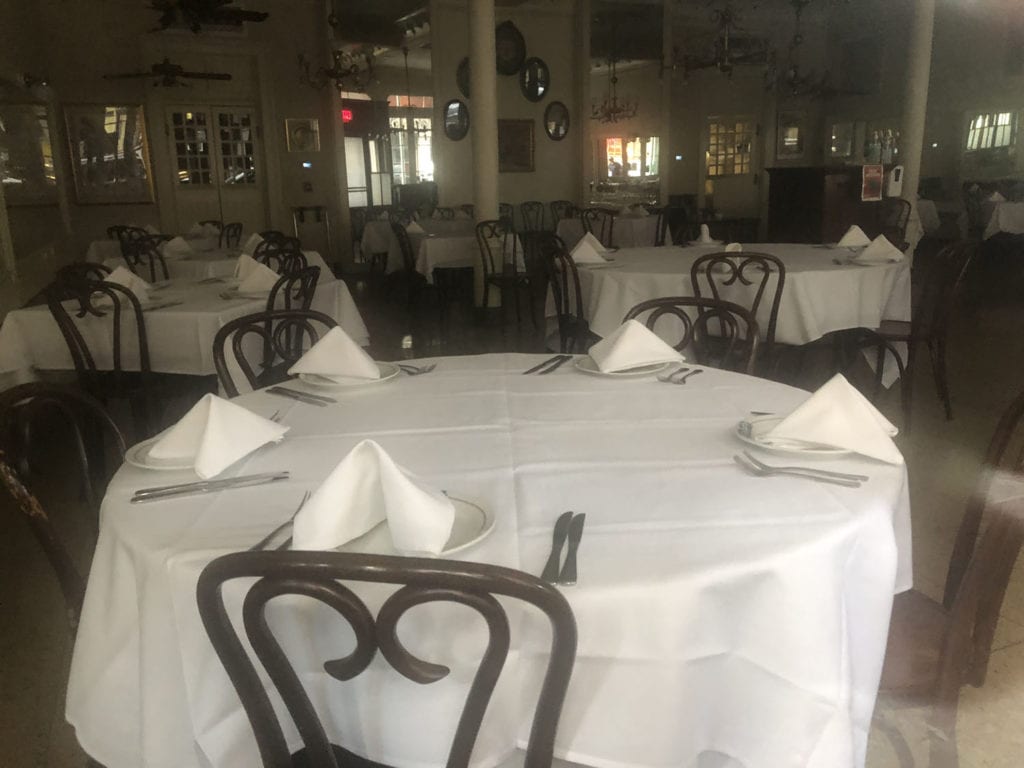
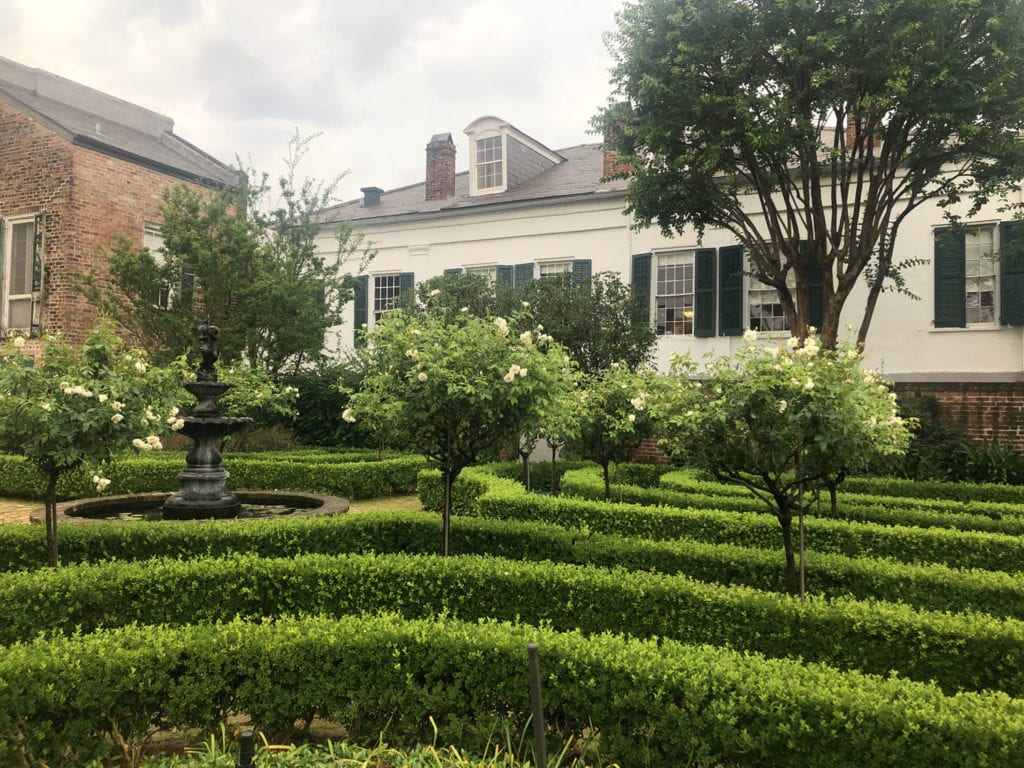
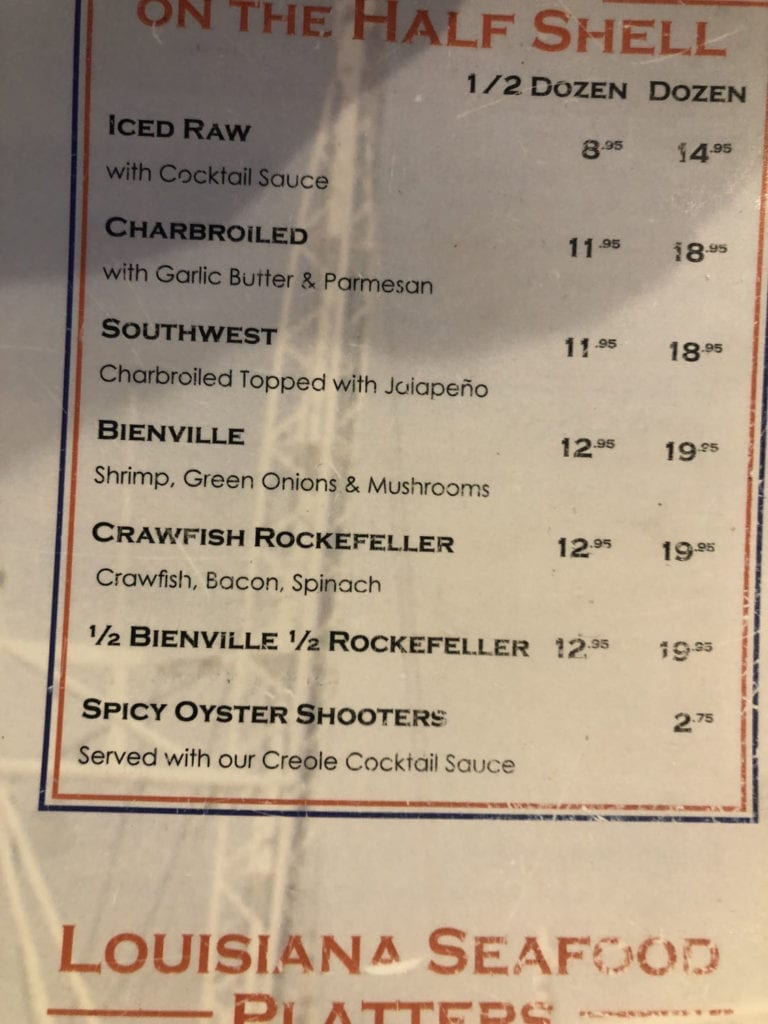
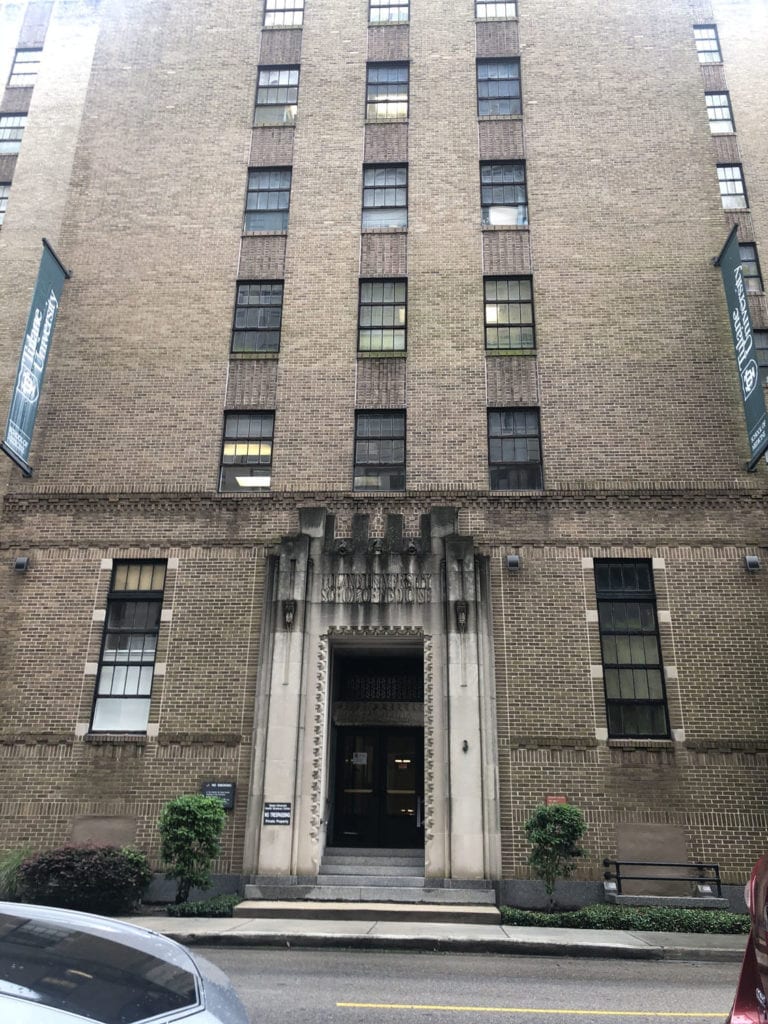
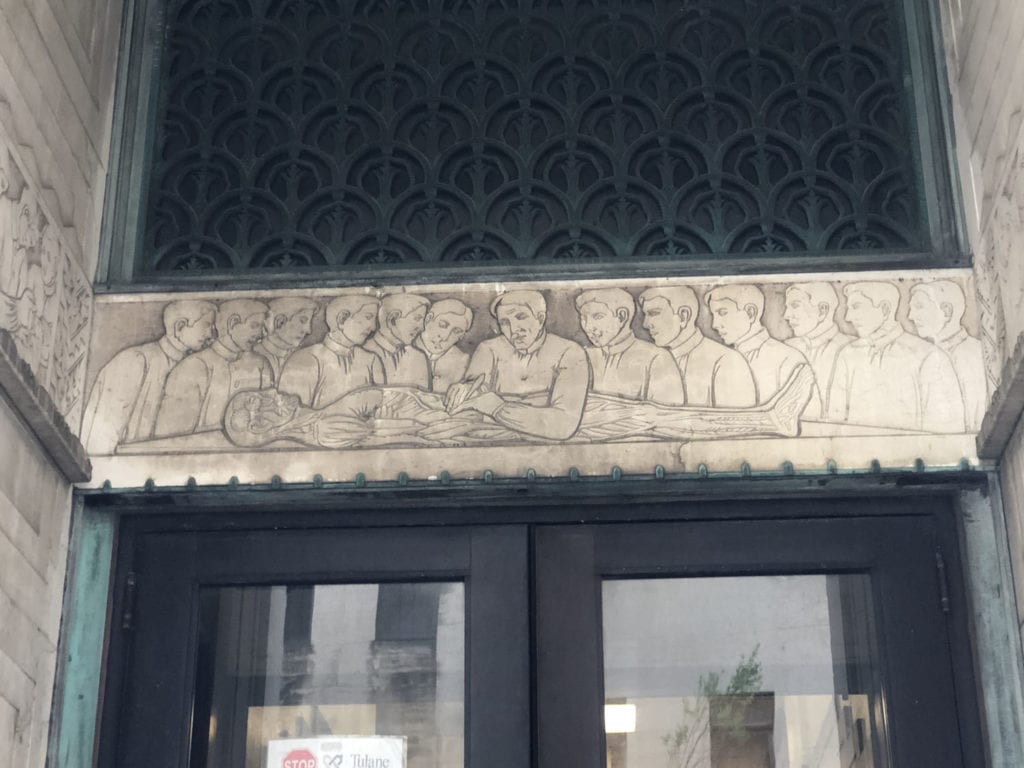
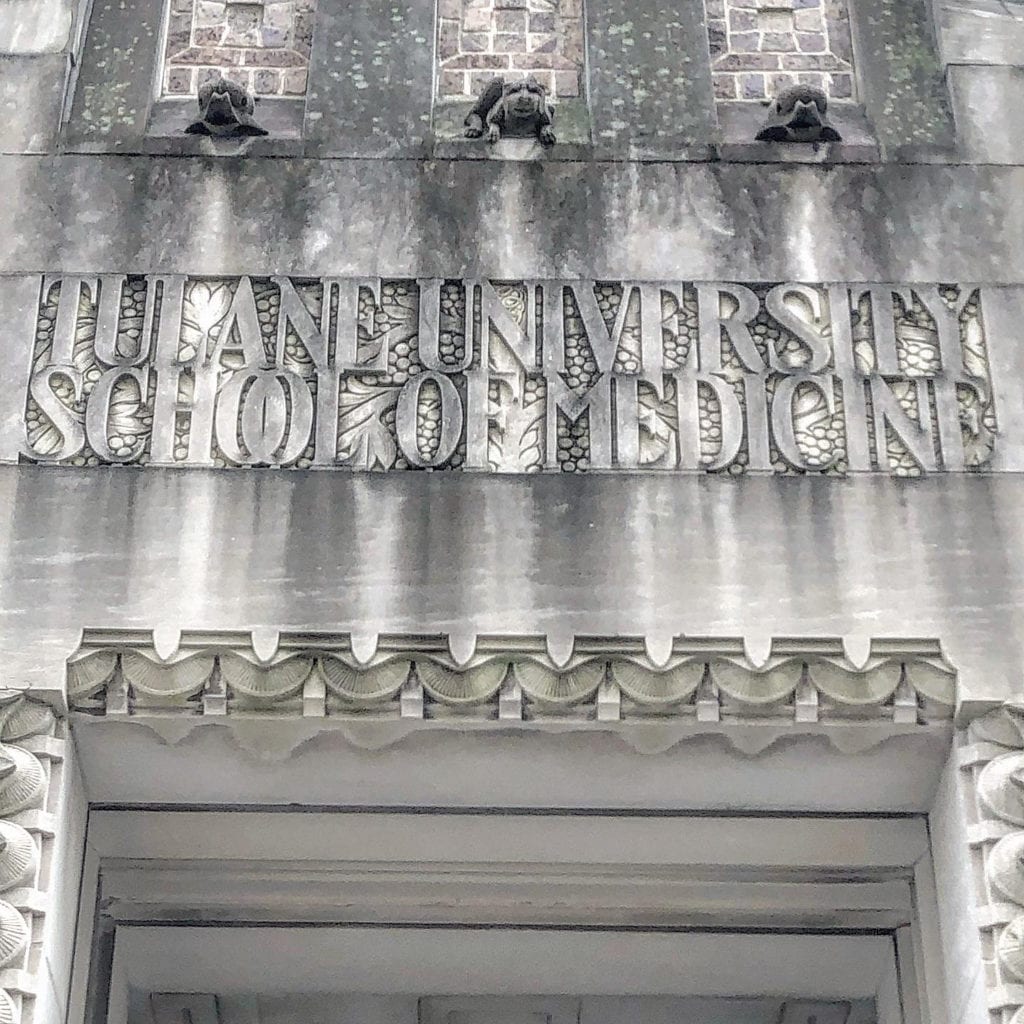
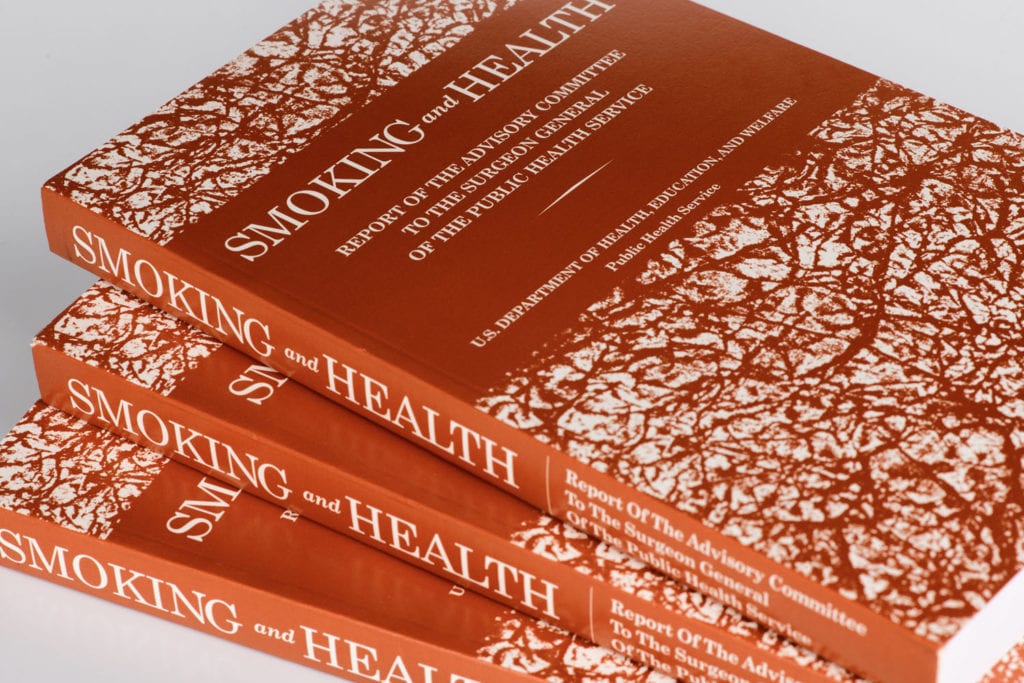
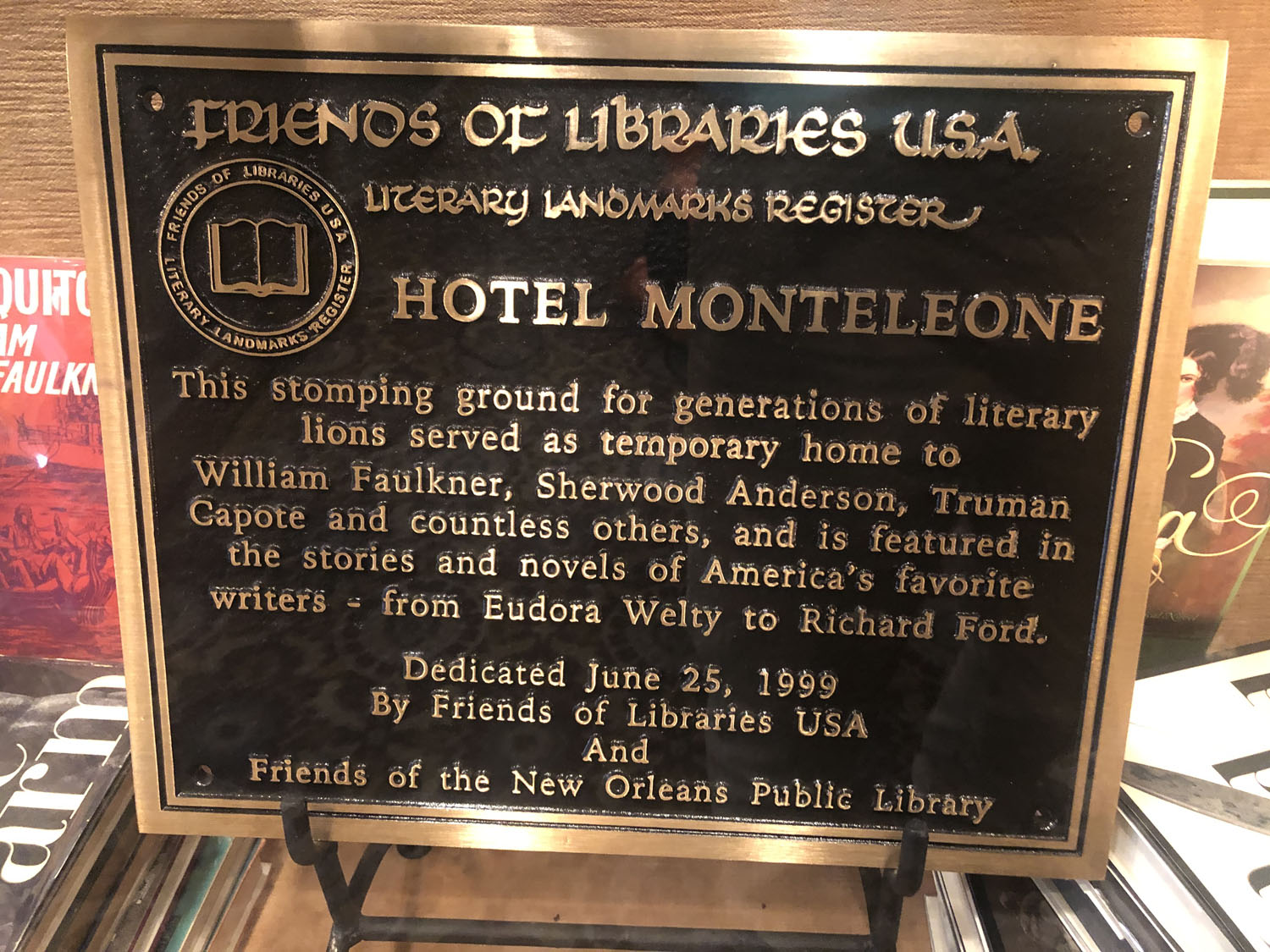
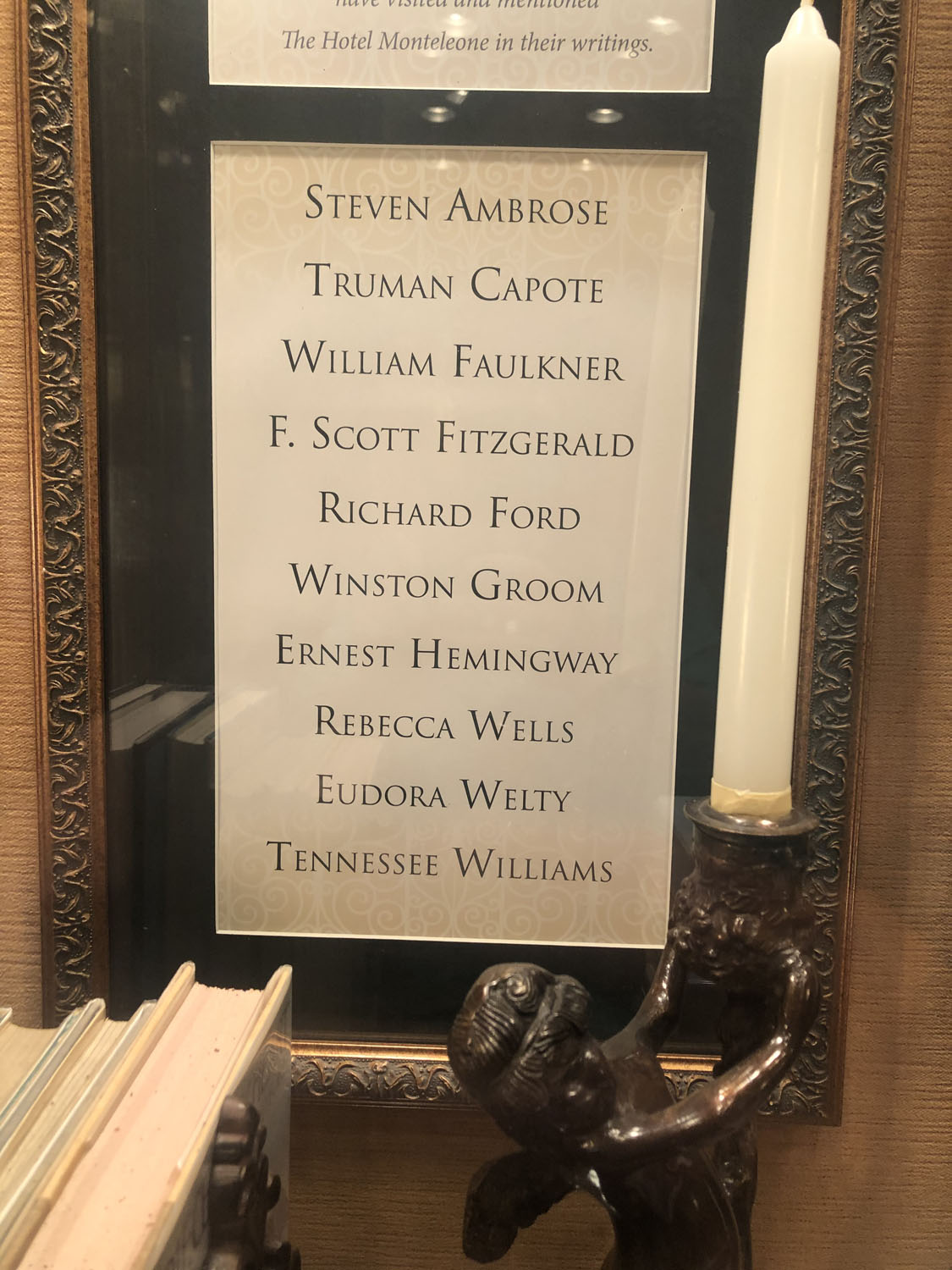
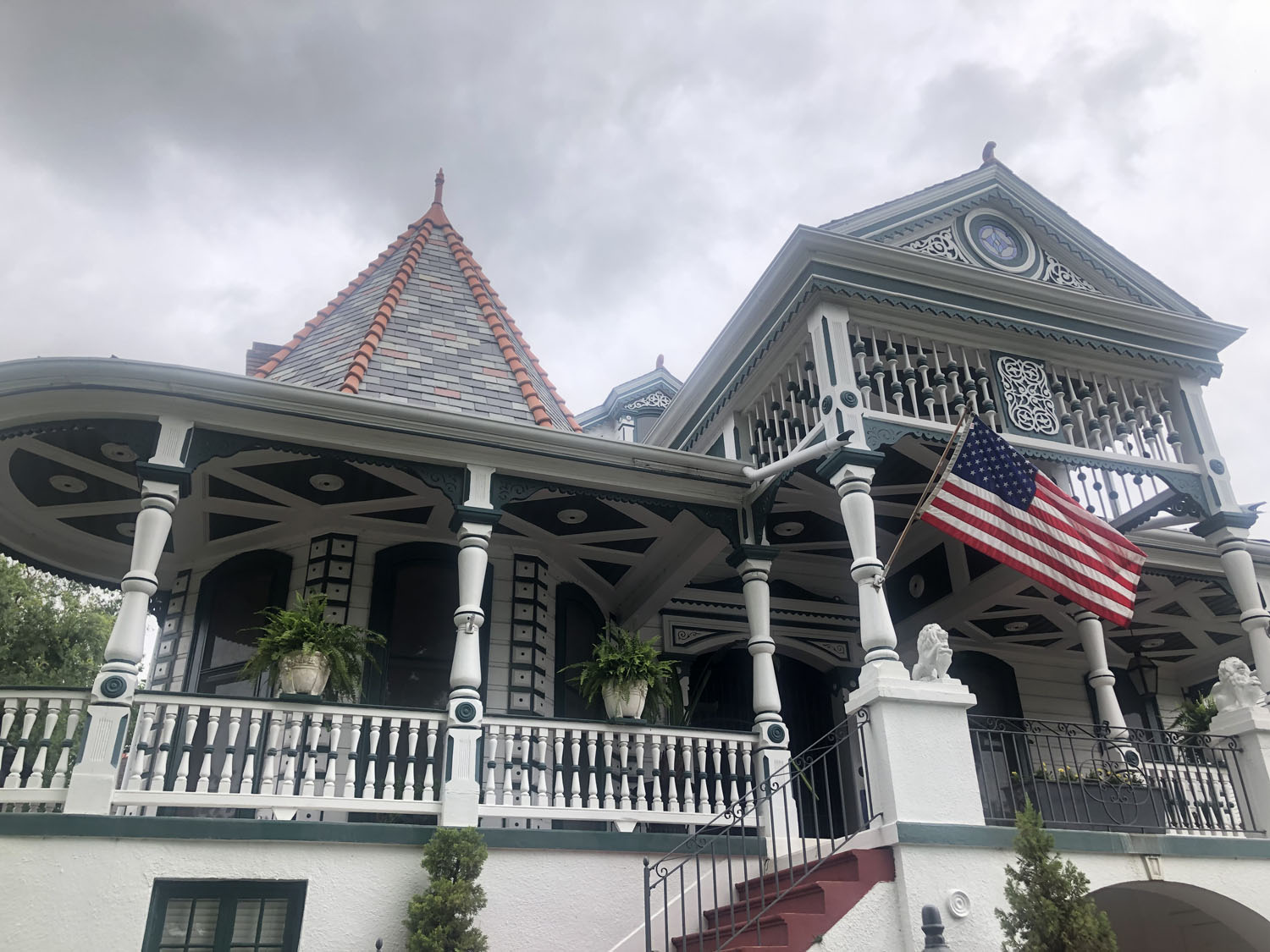
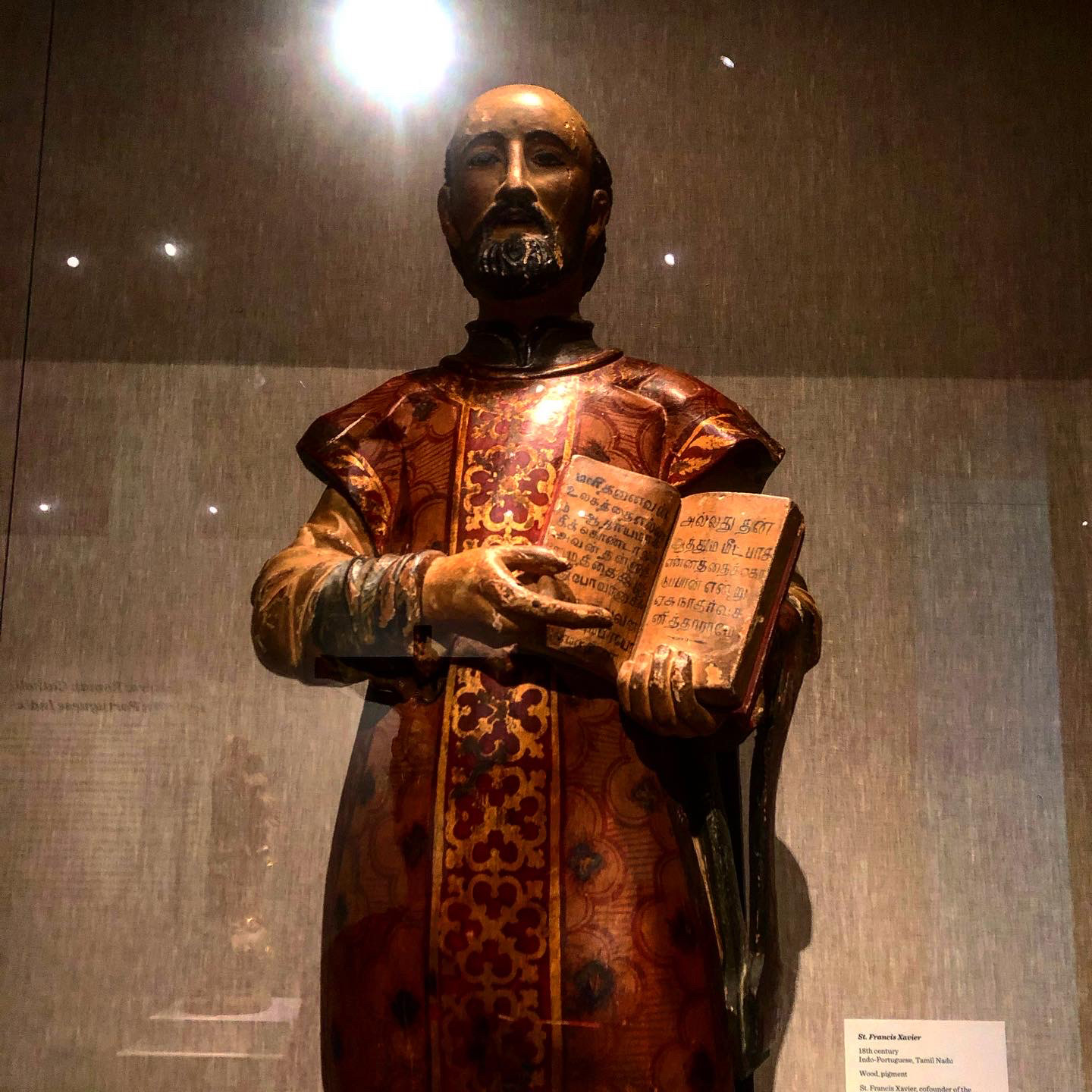
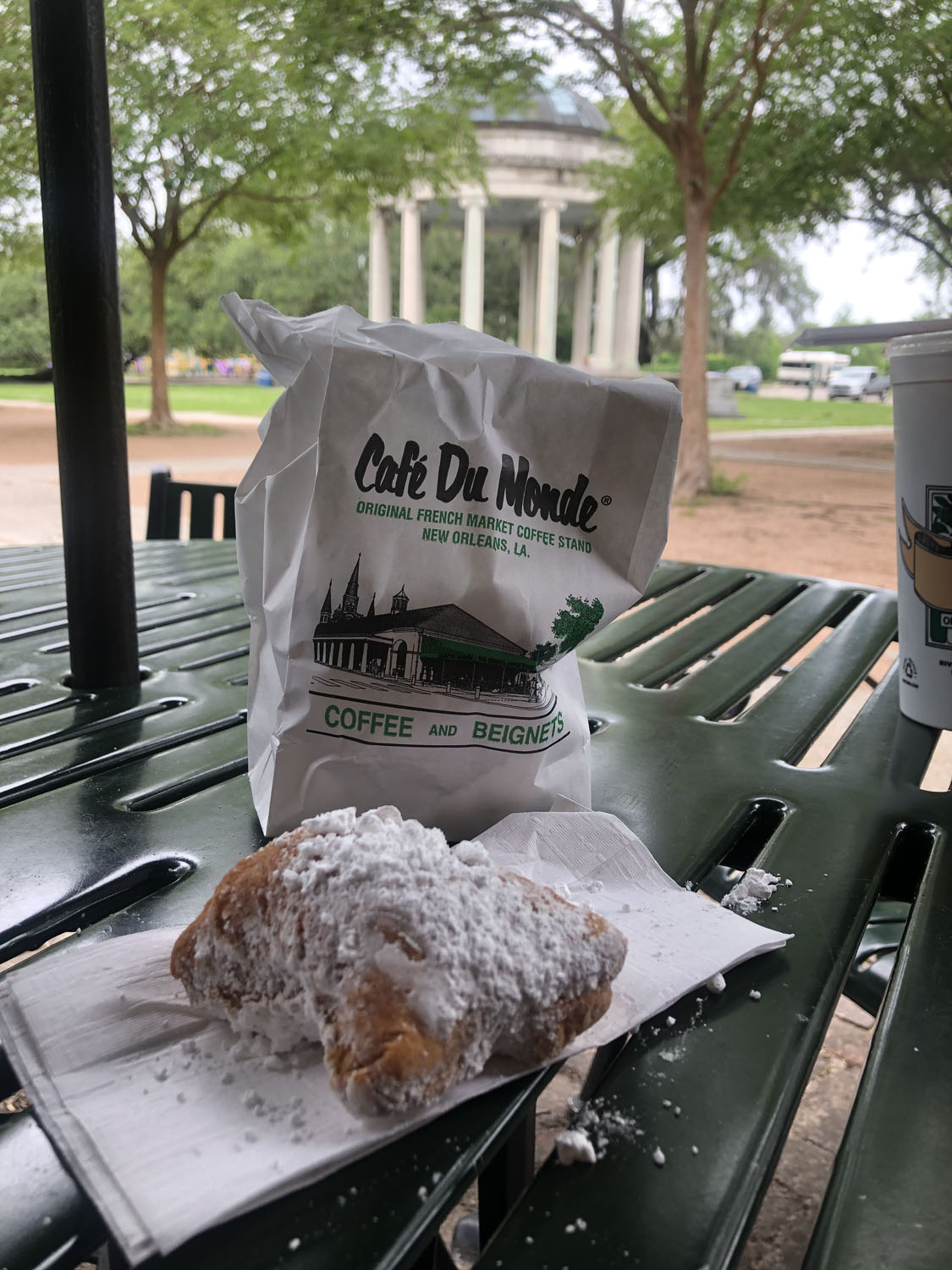
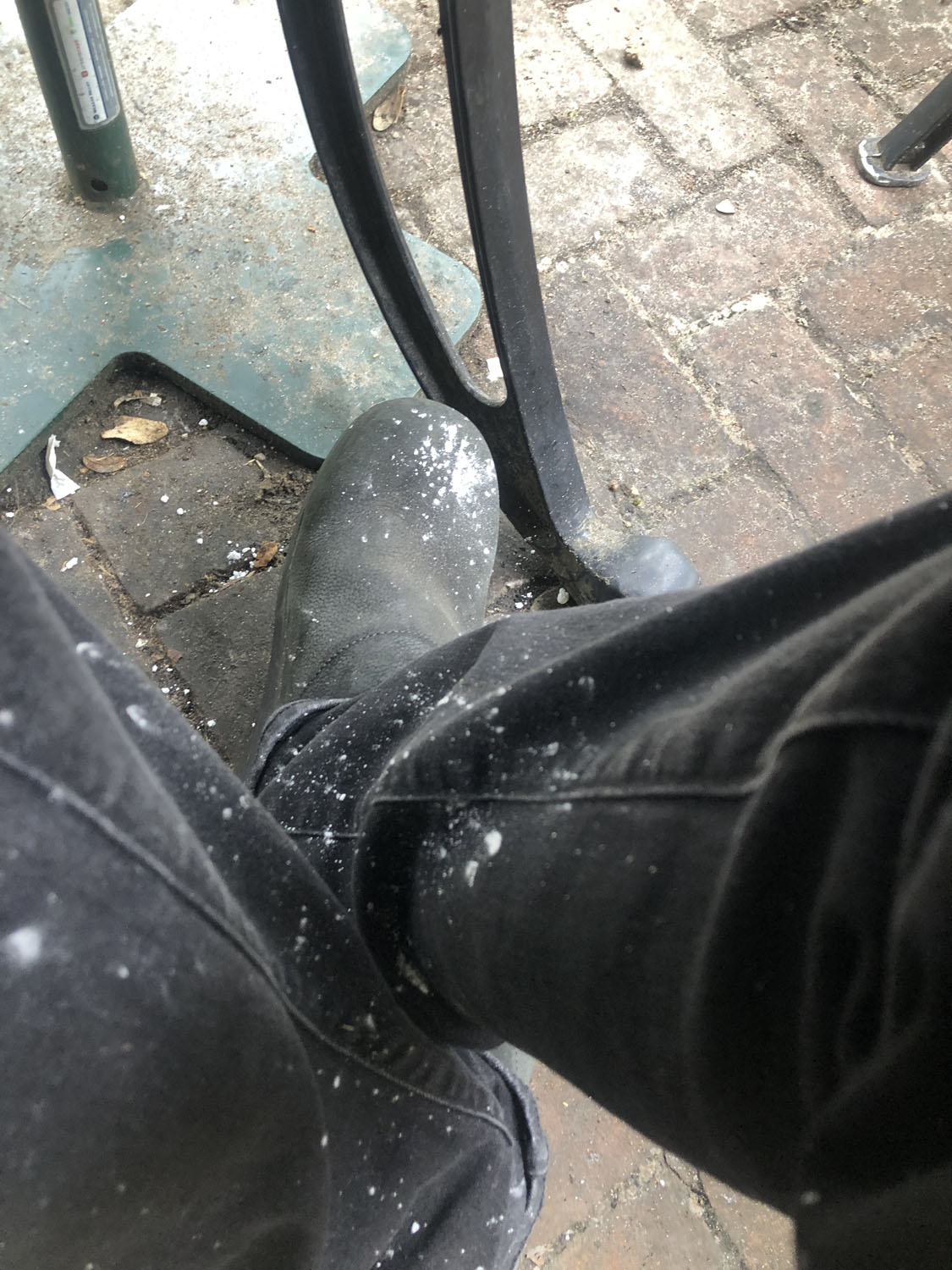
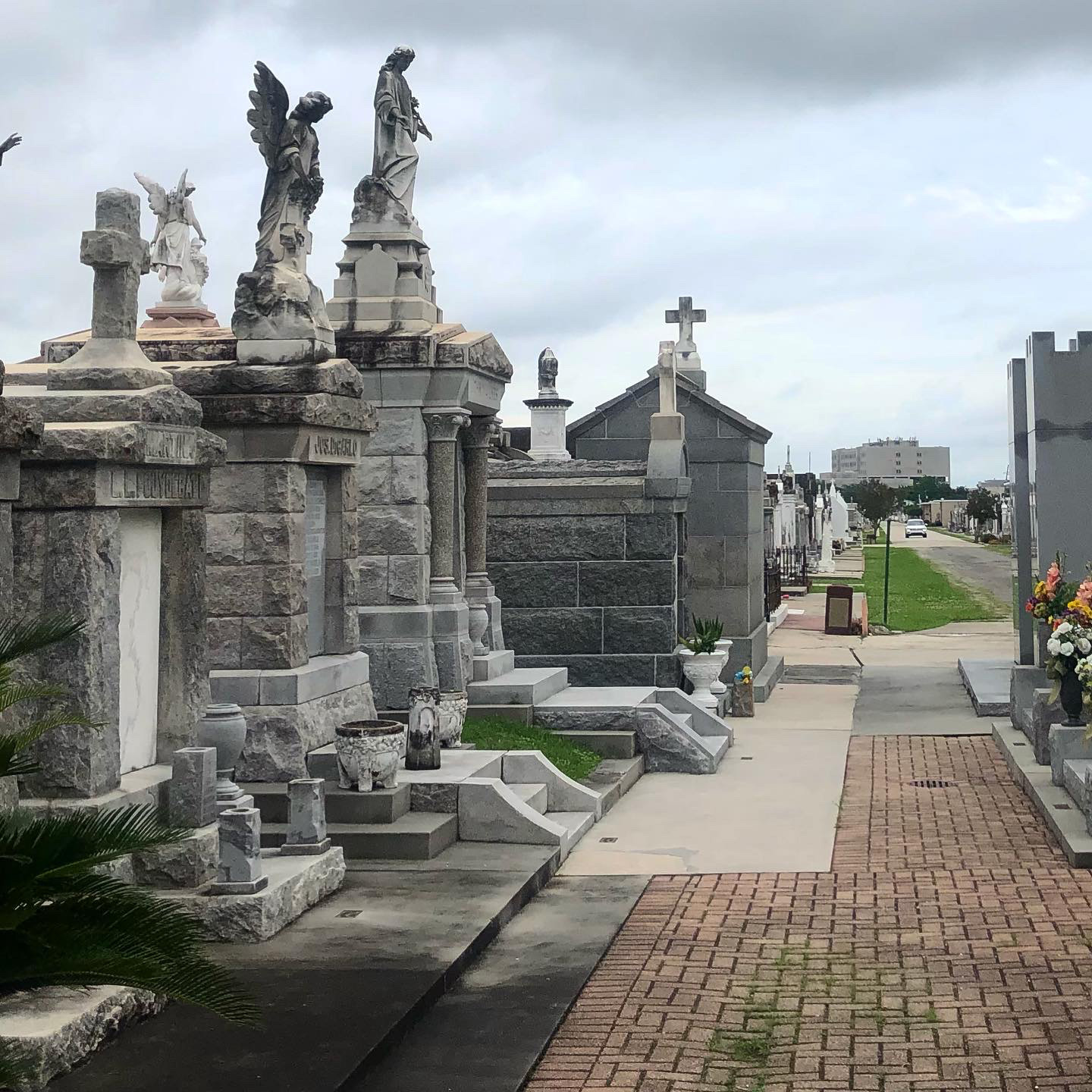
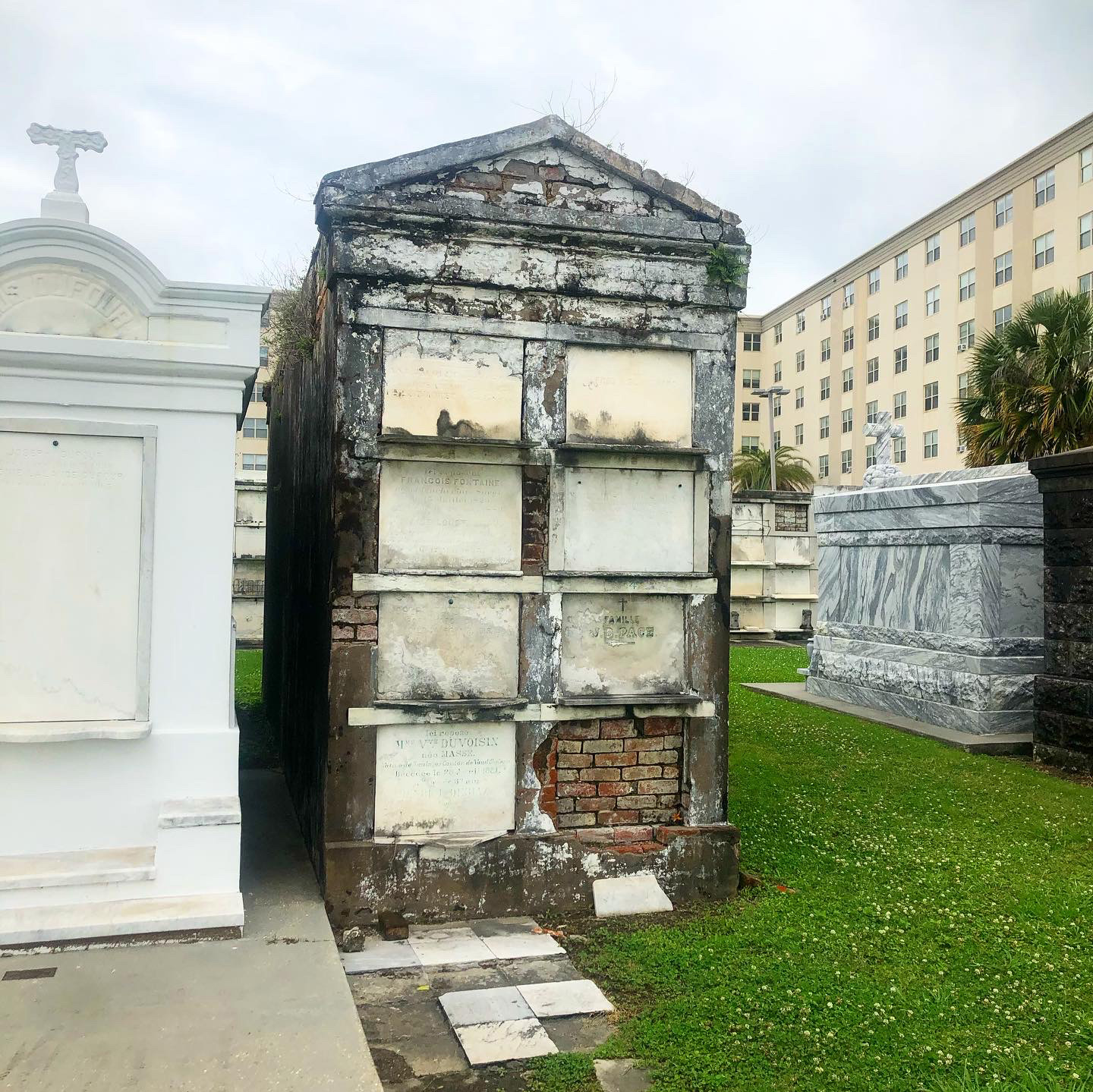
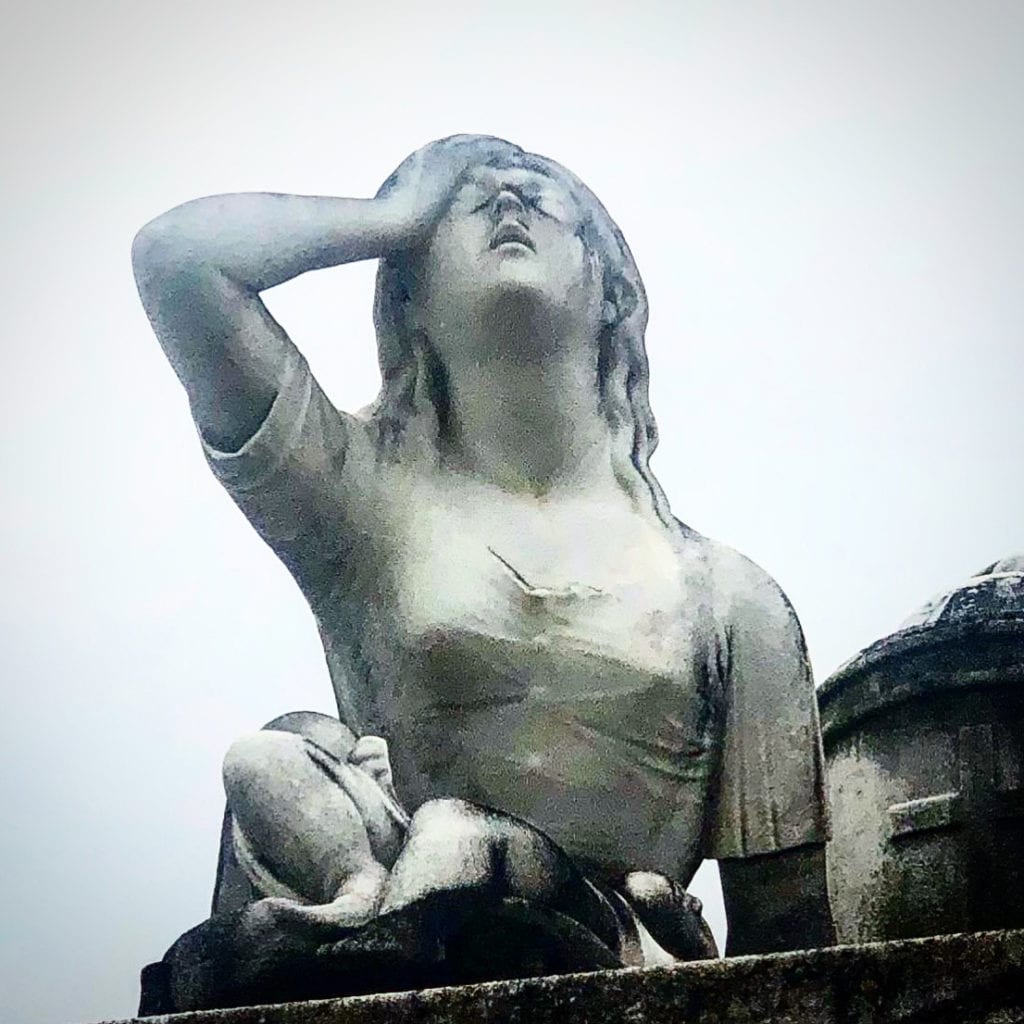
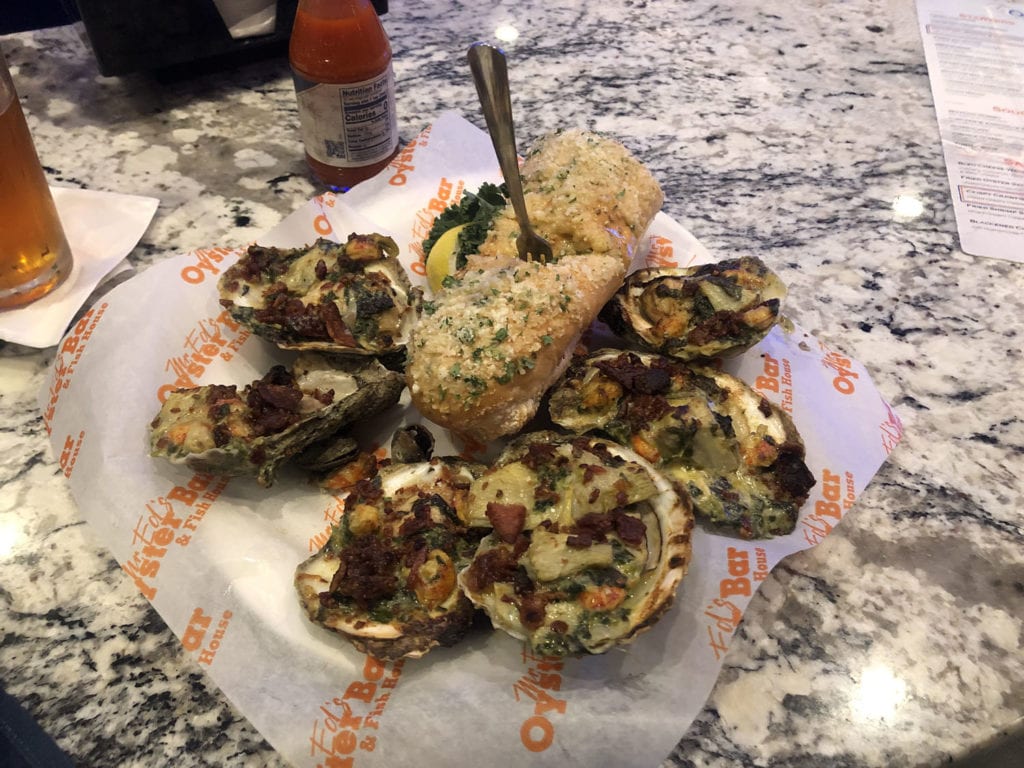

Test
As a native Neworleanian, it was enjoyable to vicariously revisit so many familiar haunts via your blog! Thanks.
Thank you Andrew.
It was a very enjoyable trip!
I appreciate your taking the time to read and write!
Best
Chuck